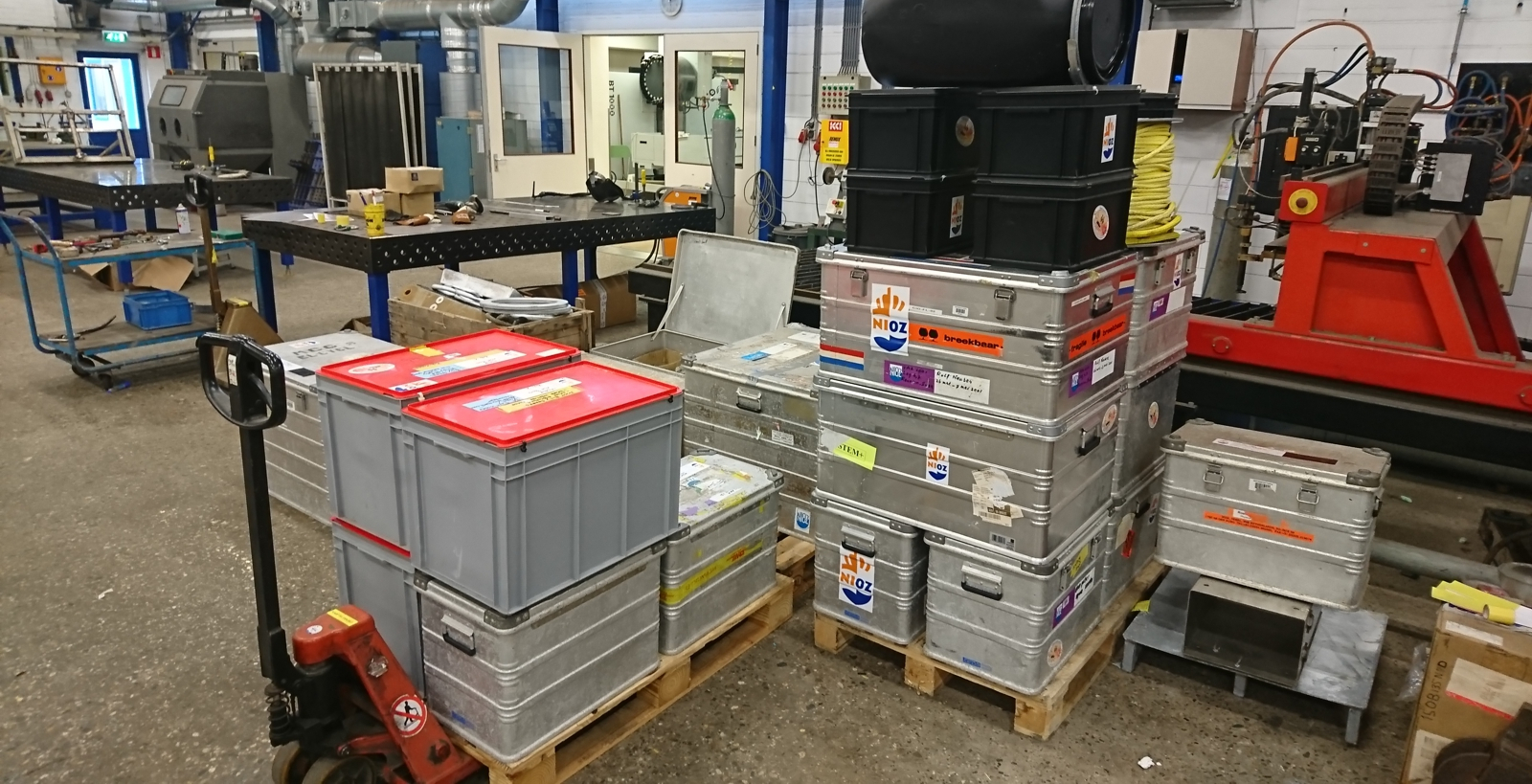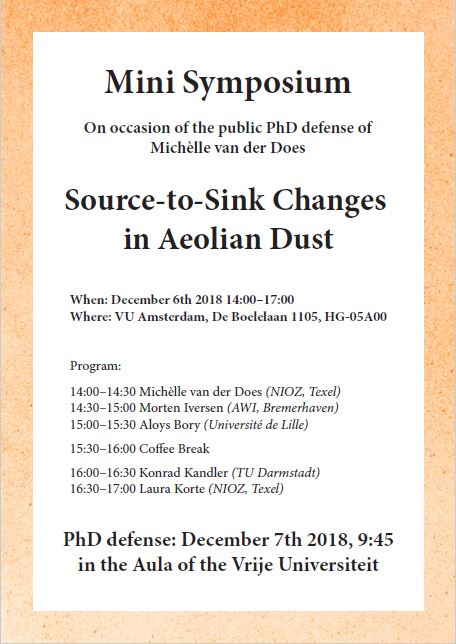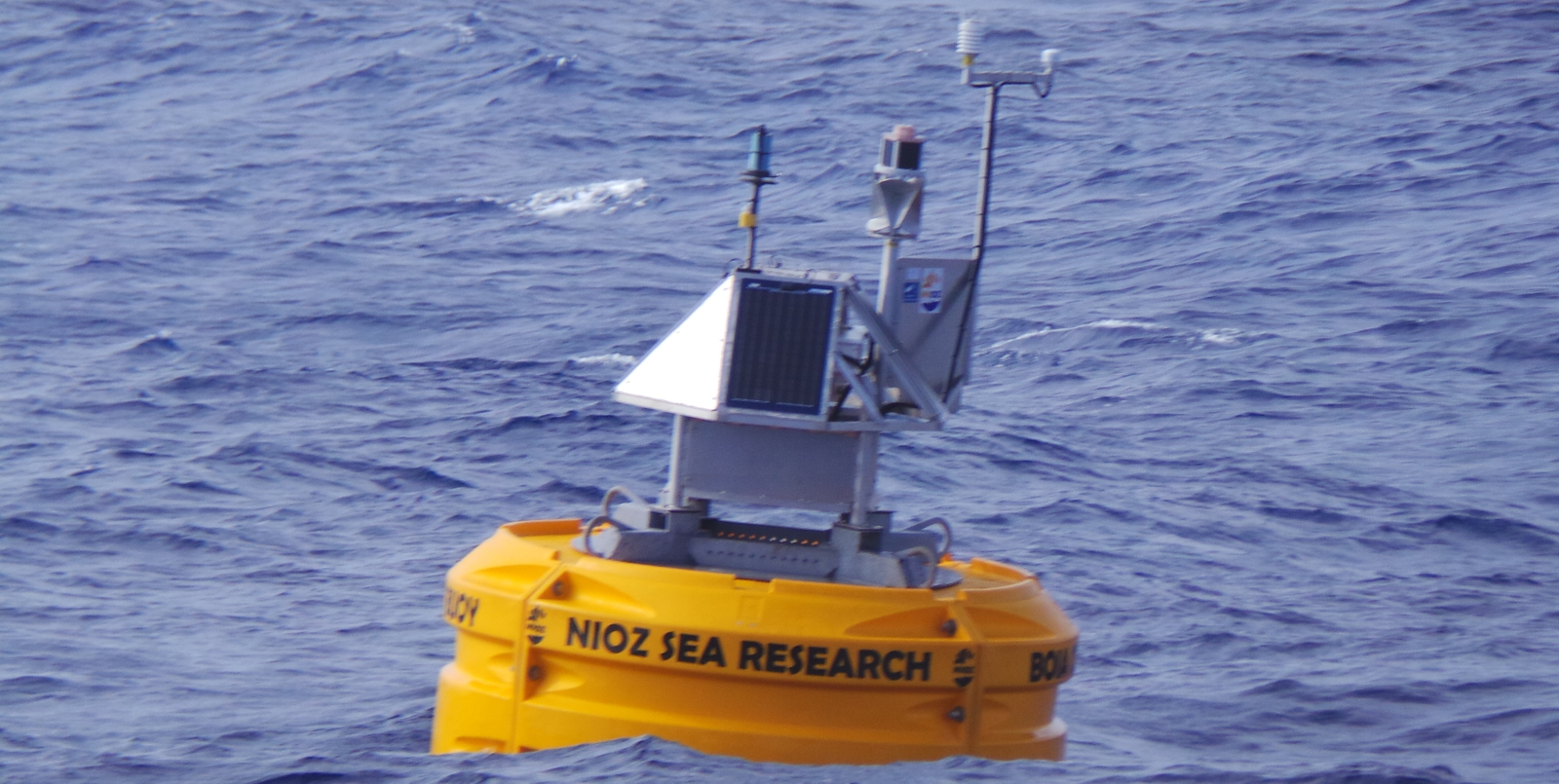
Expedition MSM79 consists of two parts: Eurothaw --which is dedicated to studying the transition from the last Glacial into the present interglacial-- and Macpei , which aims to study the role of the NW African high-productivity area in the global carbon cycle. Please also see the website dedicated to this expedition on the MARUM website as well as the blog that is kept on that site (in German).
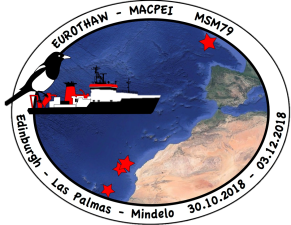
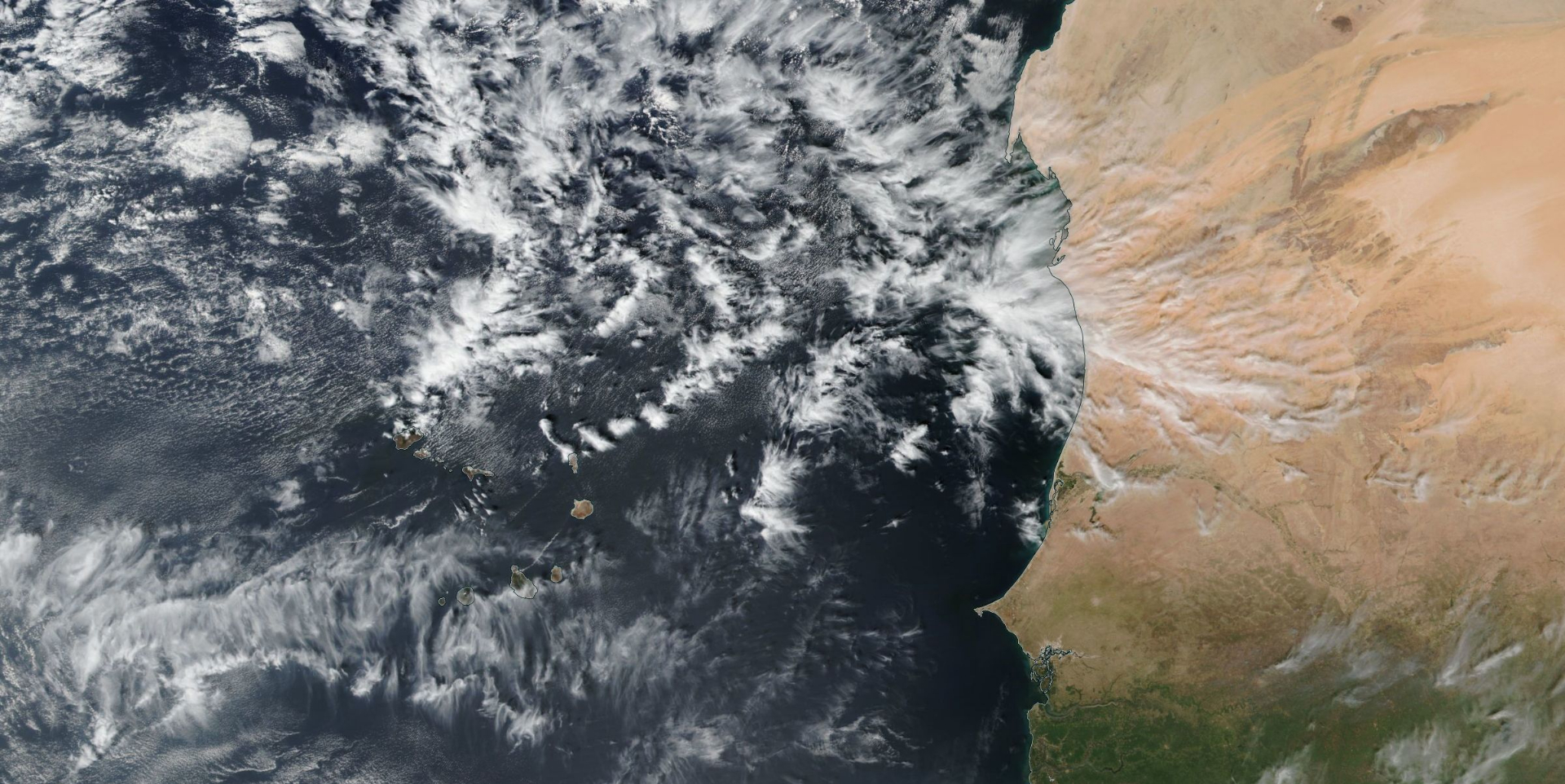
As you can see on the satellite image above there is not a lot of dust around on- and offshore Mauritania on 3 November 2018. We are obviously hoping for more dust during the next four weeks!
Click MS Merian's logo to see her actual position.
(link to external website)
On 30 October the Maria S. Merian left the harbour of Edinburgh heading south. Her first stop was just south of the English Channel where a long sediment core was drilled to study the outflow from the European tundra during the last ice age. On 9 November, the research vessel will shortly enter the port of Las Palmas de Gran Canaria (Spain) to receive fresh stores, fuel and scientists. On the same day we will then head towards Cape Blanc at about 21N/21W. At this position the Bremer colleagues have been monitoring sedimentation through the water column since 1988, using so-called sediment traps. Initially, the focus was on studying the carbon cycle in an area that is characterised by high surface productivity, related to upwelling of nutrient-rich waters along the coast of Mauritania. After some time the people realised that this spot is also a key location to study (the marine-environmental effects of) Saharan dust. In 2013 we have added our dust-collecting buoy "Carmen" to monitor Saharan dust directly from the atmosphere. This site now contains one of the longest continuous sediment-trap records in the world and we are very excited to continue working on it!
===================================================================================
Regular updates below this line:
3 December: Mindelo on the island of Sao Vicente, Cape Verde Islands: end of cruise MSM79!
We have reached our destination after about four weeks at sea.
Many thanks for following this blog!
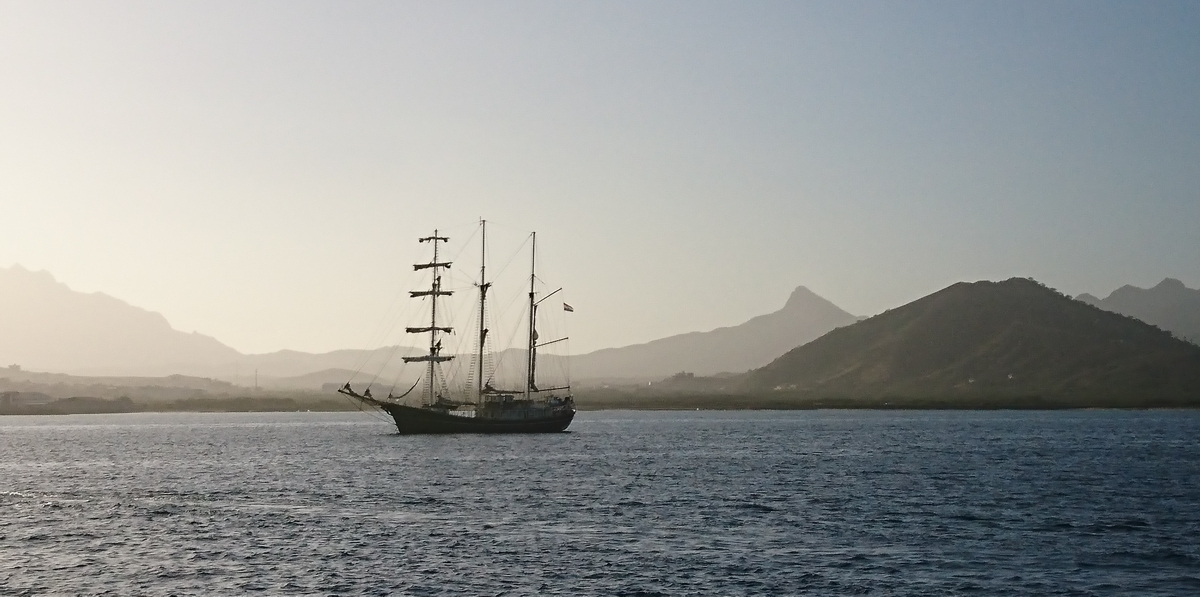
2 December: dusty sunrise
Here is what a nicely dusty sunrise looks like! Although the sun is already way above the horizon, her light is still obscured by the low-level dust through which we are sailing. Only if you look straight up into the sky, one has the feeling that the sky could indeed be blue.
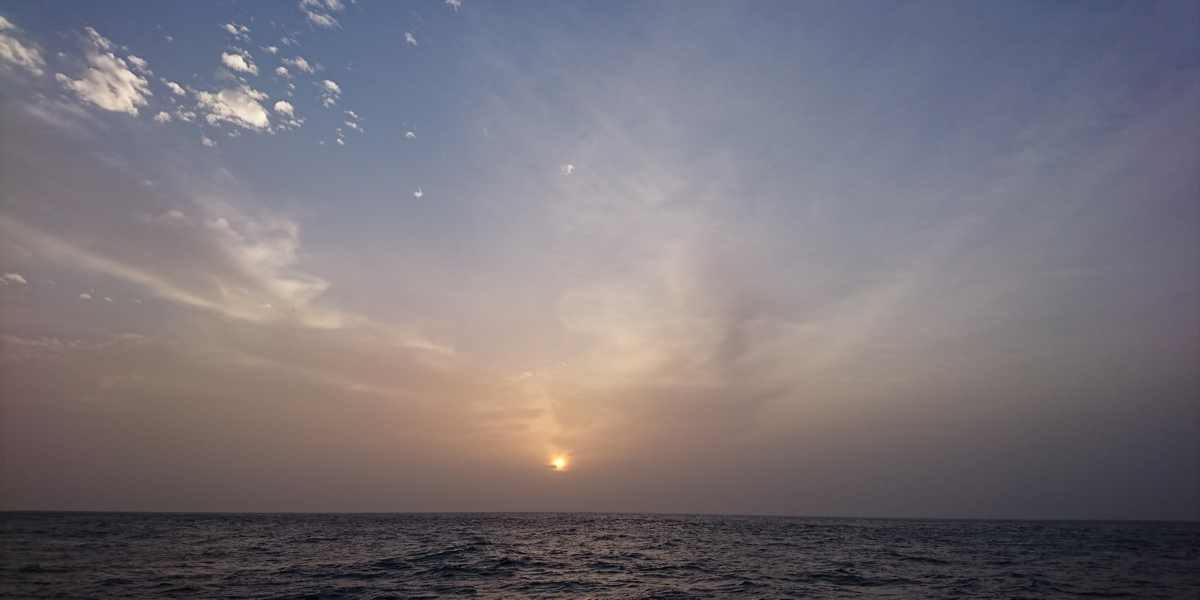
2 December: peek into dust buoy
Here you get a peek into dust-buoy Laura, where you can see the carrousel with the filters. Each filter is about 6 cm in diameter, containing standard 47mm filters. These particular filters have been sampling for 24 days in a row and as you can see they caught quite some material! With the amounts of air passing through, we can calculate dust concentrations, which will be of great help to calibrate satellite pictures that also aim to turn their optical-thickness measurements into concentrations.
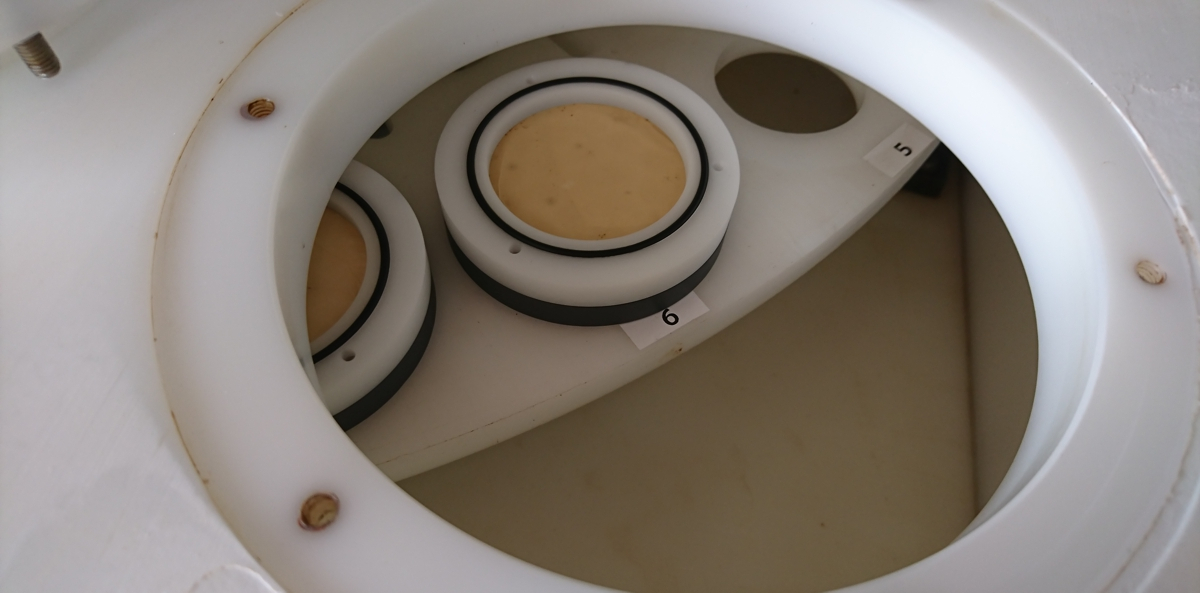
2 December: dust ahoy!
After 3½ weeks of no dust whatsoever almost the entire area that we’ve sailed through is blanketed by dust! The white spot indicates our actual location, some 300nm south of our final destination: Mindelo. The concentration of dust particles is –according to the website Windy.com, from which this picture was taken— more than 100µg/m³, which is 4x the amount that the World Health Organisation set as the maximum recommended concentration.
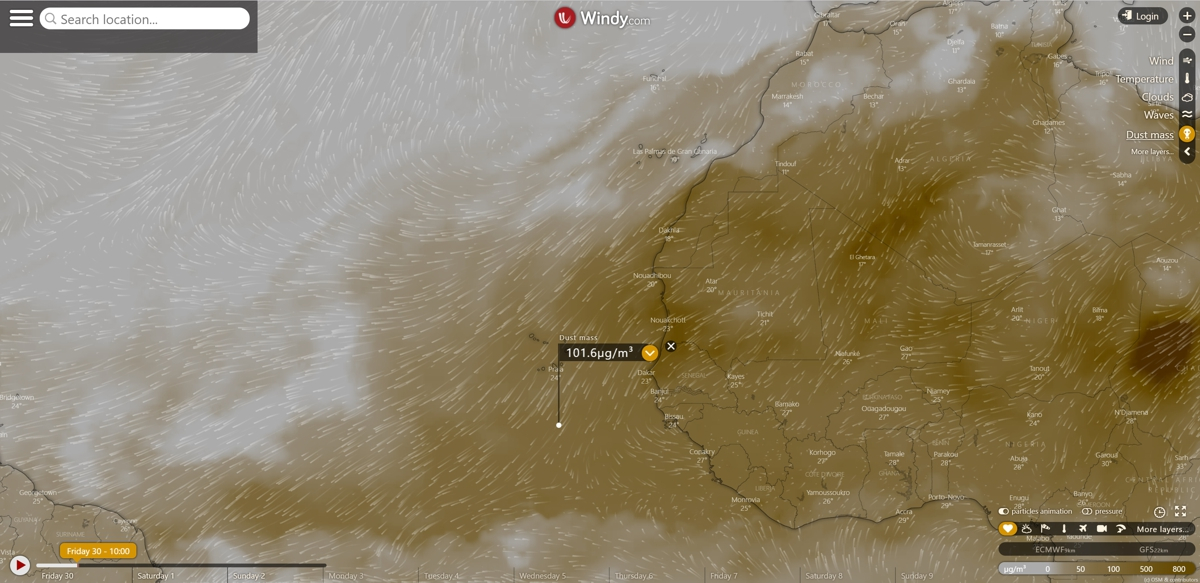
2 December: Macpie gang
Here you find the complete scientific party of RV Maria S. Merian cruise MSM79. Front row, R2L: Sandra, Laura, Charlotte, Janina, Bob. Second row R2L: Frederik, Marco, Gerard, Marcus, Jan Dirk, Jane, Jan-Berend, Barry. Third row R2L: Chief Karin, Birgit (hiding behind Frederik), Barbara, Karl-Heinz, Hendrik, Götz, Martin.
1 December: green flash?
At really clear-sky conditions the atmosphere can work as a prism, causing a green flash just after sunset. Now that there is no dust in the atmosphere yet, we keep hoping seeing one!
30 November: hunting plankton
Plankton is around in many forms. In this lab, the larger ones are studied directly with the microscope, the smaller types are filtered out of the water for further analysis back home. The upper photo shows Barbara (MARUM), who studies foraminifera (calcifying protists usually less than a mm in size), Jane (Univ. Westminster, UK) and Gerard (MARUM) who specifically study the dinoflagellates (marine algae of about 25µm). The lower photo shows Karl-Heinz (MARUM) who concentrates an even smaller phytoplankton type called coccolithophorids (calcifying algae with an average size of 5µm). The aim of the study is to test if there are changes in the species composition across the development of a single occurrence of cold upwelled water. For this reason, we have followed such a filament for 7 days and sampled it at various depths using the drifting traps.
30 November: water analyses
Several onboard measurements are already being carried out, such as the oxygen content of the water. Here you see how MARUM-colleague Charlotte determines the amount of dissolved oxygen in the little water bottle by pressing an optical sensor against the bottle. Obviously, the amount of oxygen is important for many biological processes in the ocean.
29 November: wildlife
Apart from some splashes in the far distance, most likely caused by jumping dolphins, and the occasional sea turtle, the wildlife that we spot is limited to squids at night and gannets during the day. The squids are lured by the ship’s lights when we are on station, sampling water. The gannets are most likely around to catch fish (that we don’t see but because of which the many fishing boats are around).
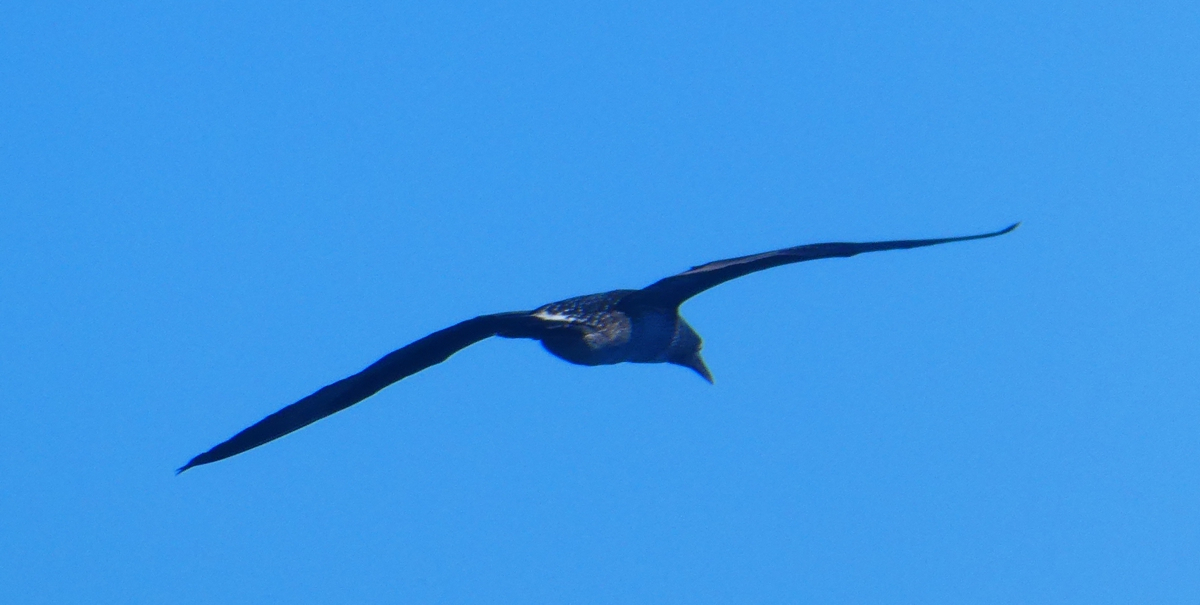
28 November: daily routine
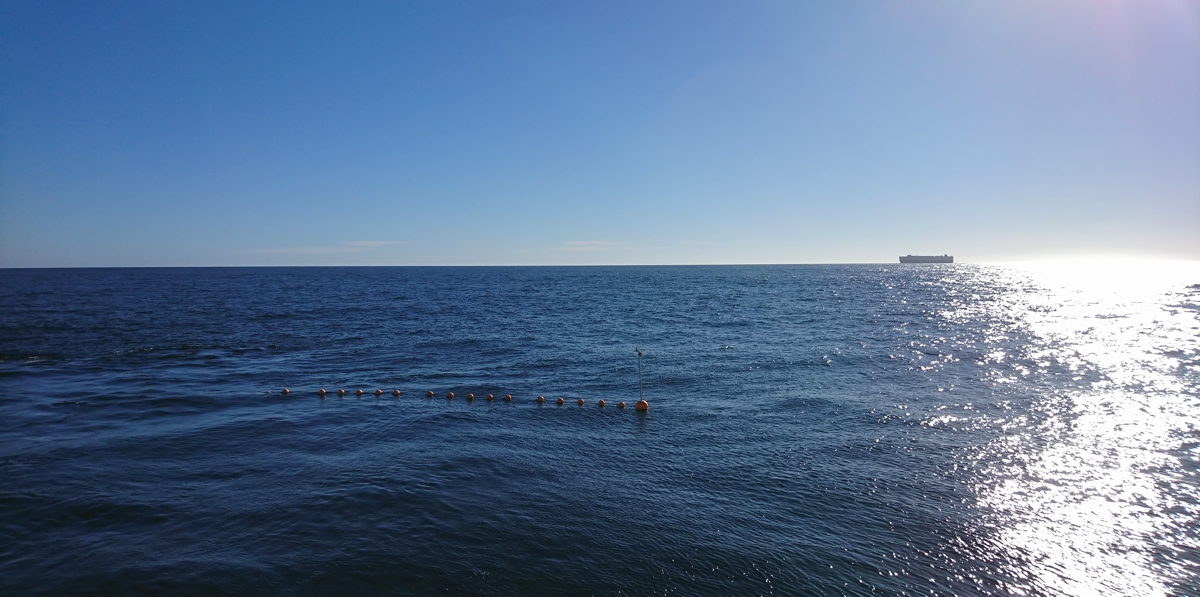
When we were off Mauritania chasing the filmaents, every morning after breakfast, we started recovering the drifting traps that the officers on the bridge had already spotted at dawn and maneuvered the ship close to. This was very convenient since in the mess where all were having breakfast, we could easily see when the time had come to go on deck and help out with the recovery of the instruments and gear (see below for a view from the mess window).
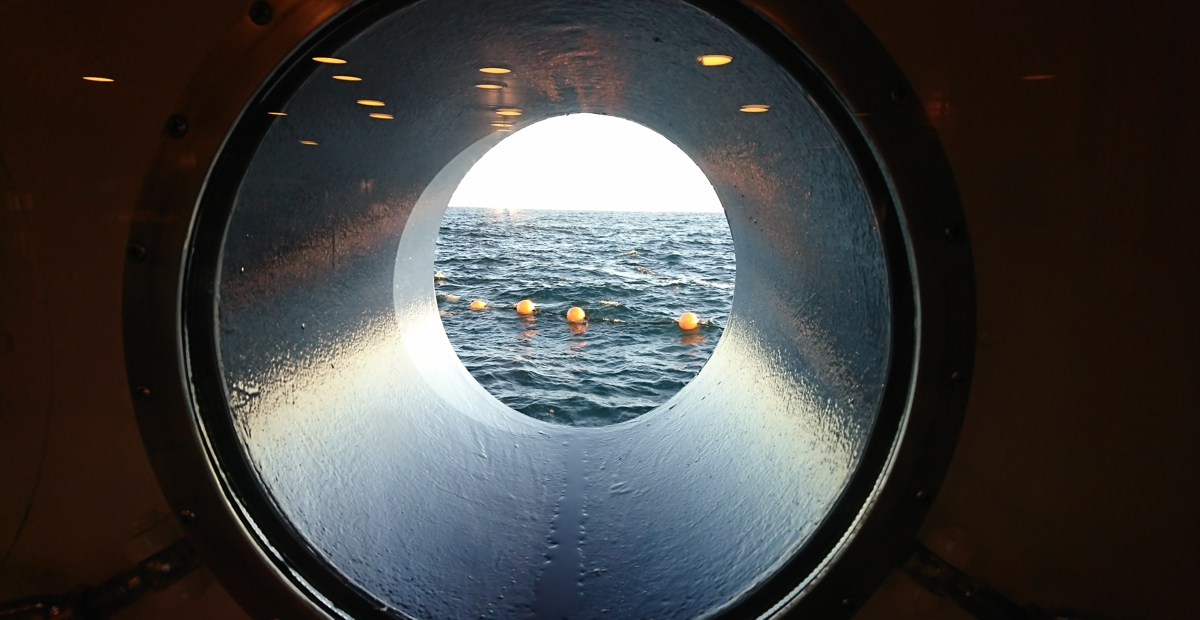
27 November: chilly waters
On this satellite image of the ocean’s surface temperature (image courtesy of NASA and downloaded from the “state of the ocean” website) one can see how -thanks to coastal upwelling- sea-surface temperatures are significantly lower directly off the northwest African coast, particularly off Mauritania and Western Sahara. We have spent a week in these waters about 45nm off Cape Blanc (white arrow), still in the green colours in which we measure a temperature of about 19oC. Presently, we are on our way south towards site M1, about 200 nm south of the Cape Verde Islands and water temperatures have gone up to a pleasant 25oC again.
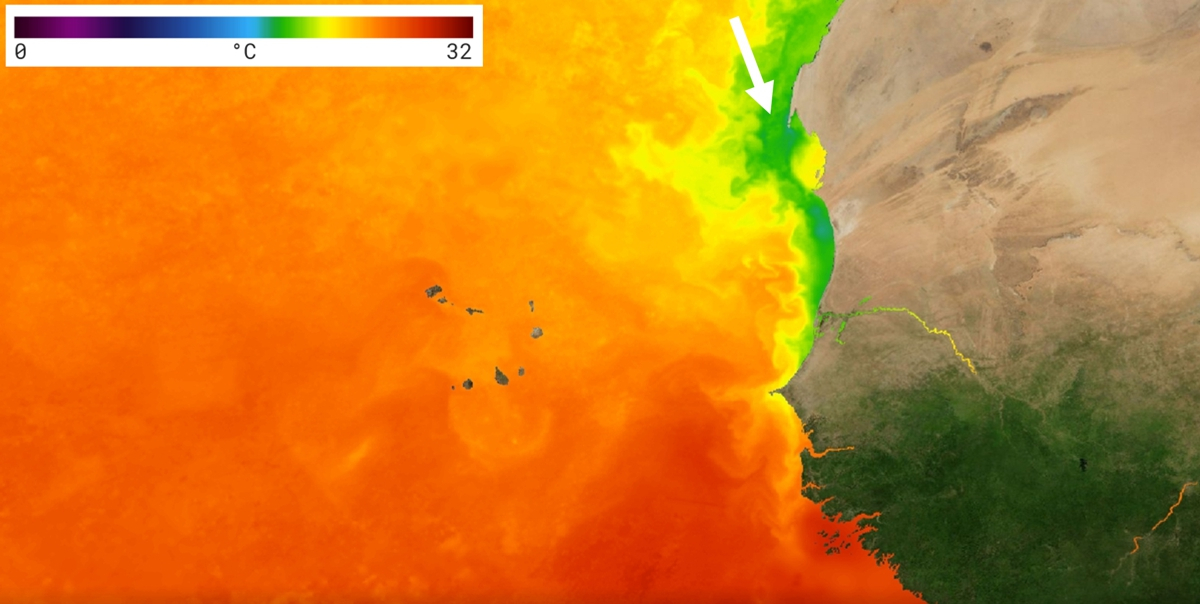
27 November: little brittle
Although our main interest is not fish, we do admire the many life forms that pass under our microscopes. Please see the MARUM blog for a report on some dinoflagellates. The little creature on this photo is a baby brittle star, a few mm big/small.
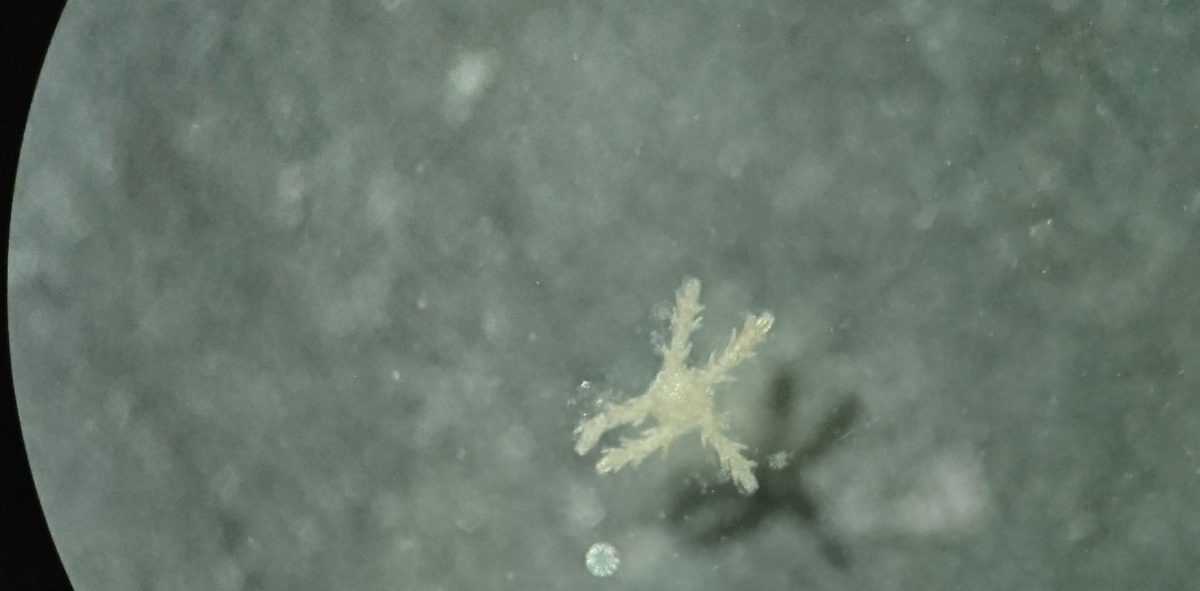
26 November: Science, not fisheries!
The part of the Atlantic that is close to the Mauritanian coast is a well-known so-called “west-coast upwelling region”, where cold and nutrient-rich waters surface. This causes a lot of primary productivity and many fish are caught in this area. For this reason, some local visitors who initially must have thought we were after their fish came to check us out. Through radio contact and after an inspection of the many instruments that are standing on deck of RV Maria S. Merian they were convinced that we are carrying out scientific research instead of robbing them of their fish.
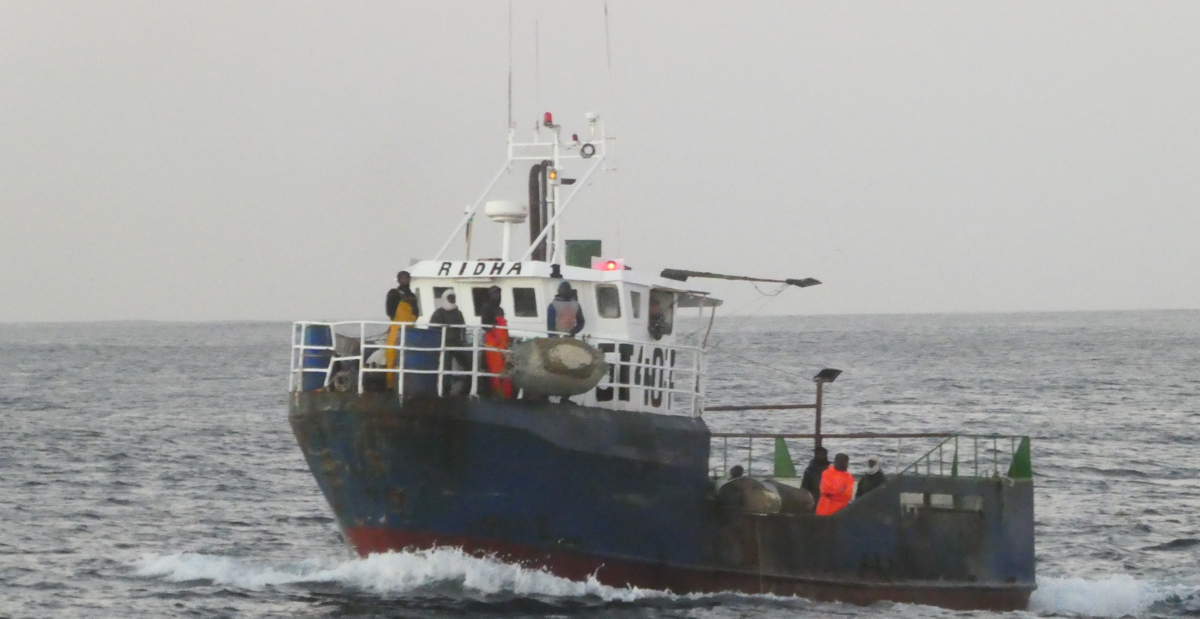
26 November: filtering water by day and by night
After the rosette (24 x 10l) is “harvested”, the cruise participants from different scientific disciplines process the samples each in their own different way, depending on the scientific questions they are aiming to answer. For MARUM-colleagues Sandra and Martin this means filtering the full load of the rosette (240l, taken at one specific depth) to concentrate the microbes and biomarkers that they want to study back home in Bremen.
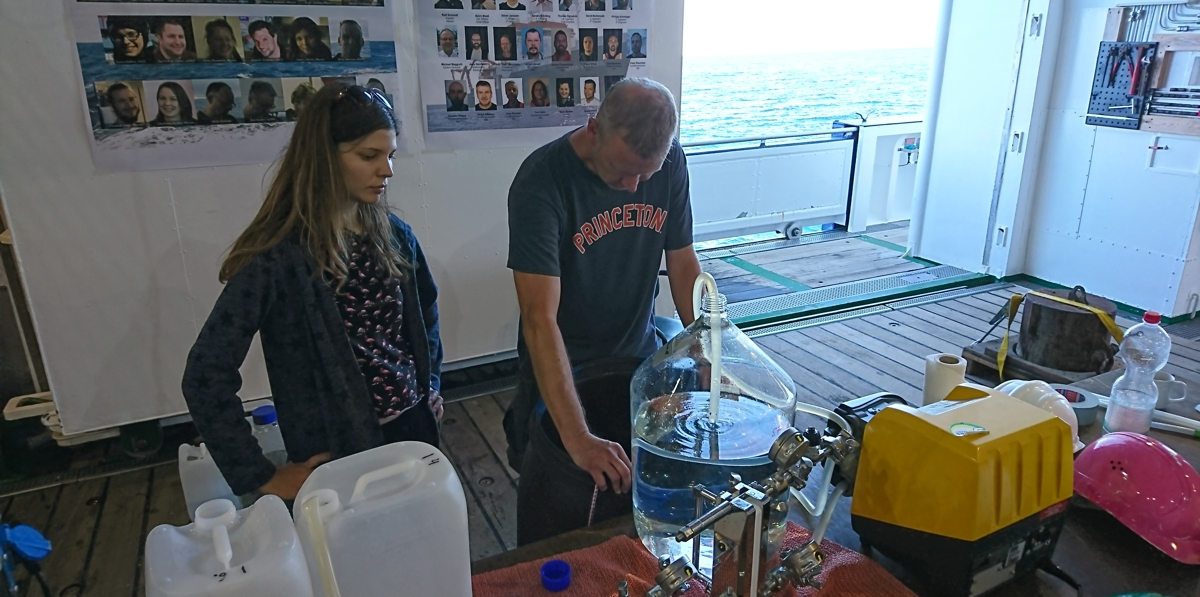
25 November: sampling by night
The working program basically runs 24/7 and a lot of water samples are being taken during the night as the instrument that we are using for this purpose is being launched through an ingenious system that can practically be used at any weather condition and sea state, and in the dark. Here you see how AB Tom keeps an eye on the so-called “rosette-CTD”, which contains 24 bottles that can sample 10l of water each. The bottles are open when they are lowered into the water (the downcast). Sensors on the rosette provide realtime information about a.o. salinity, temperature, and chlorophyll along the depth profile that the rosette takes so that on the way up (the upcast) the bottles can be closed remotely, thus sampling water at the depths of interest.
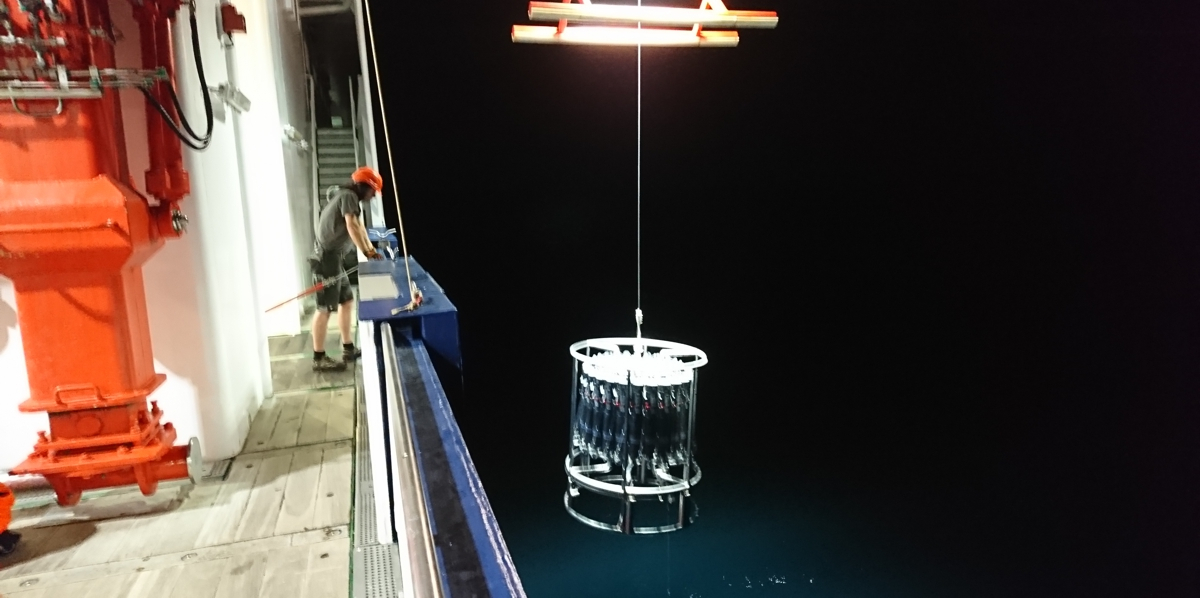
24 November: preparing the drifting traps
The string of orange plastic floats (here you see two sets that are temporarily stored in the crates) basically serves to find back the drifting traps. What really prevents the three metal-gimbals-with-four-tubes-each from sinking are these two yellow floats that each contain an air-filled glass sphere. Each float has a buoyancy of 25kg and they need to be inspected regularly to check if the glass spheres are still intact. That is exactly what NIOZ technicians Jan Dirk and Barry are doing on this photo.
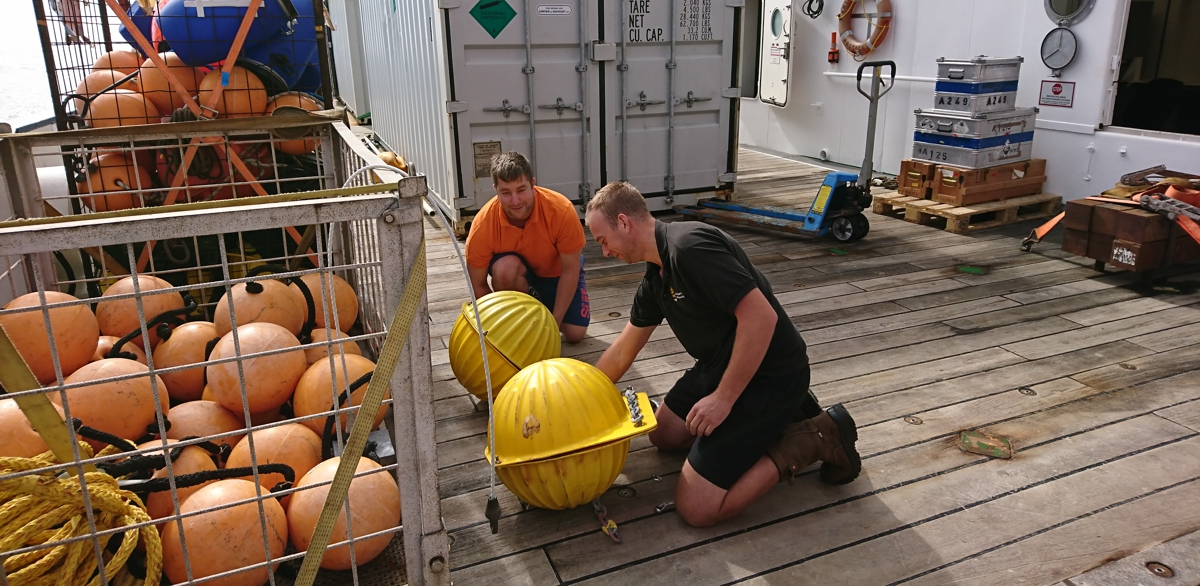
In addition to the string of orange plastic floats, the drifting traps always contain a tick larger float with some beacons on it. Here you see MARUM technicians Götz and Marco install a beacon that is visible on ship’s radars and one that sends its location to us by eMail through a connection with the iridium satellite. This way we know exactly where the traps are drifting and which track they are following. Below you see a Google Earth map with the path that three consecutive drifting traps have followed and sampled. This path is influenced by both winds and currents which may vary in direction between surface and 400m depth.
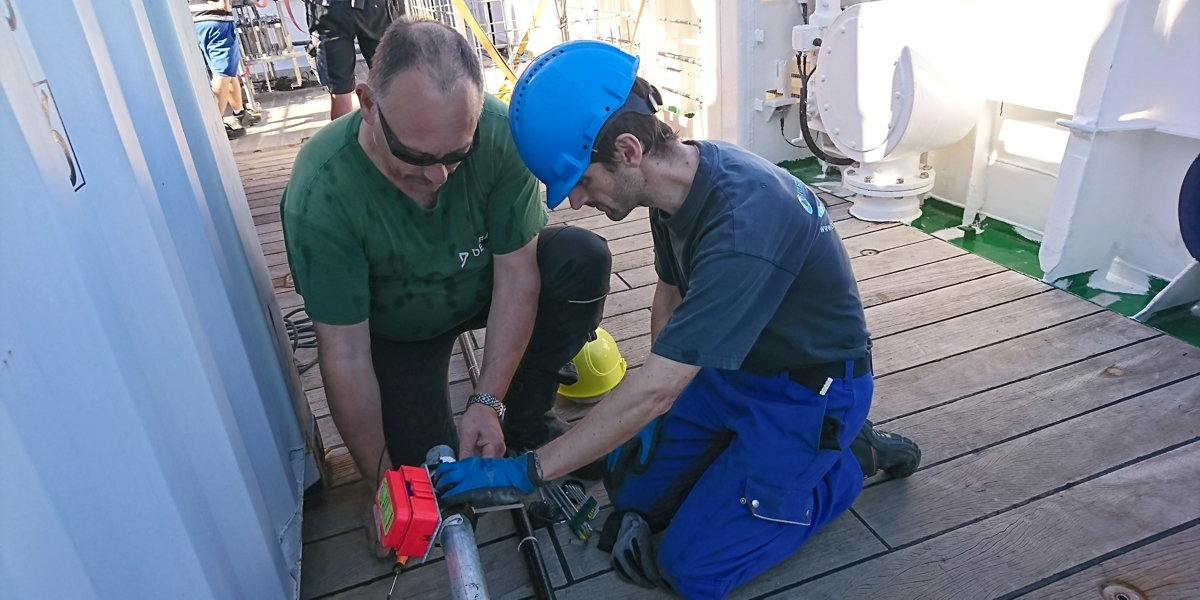
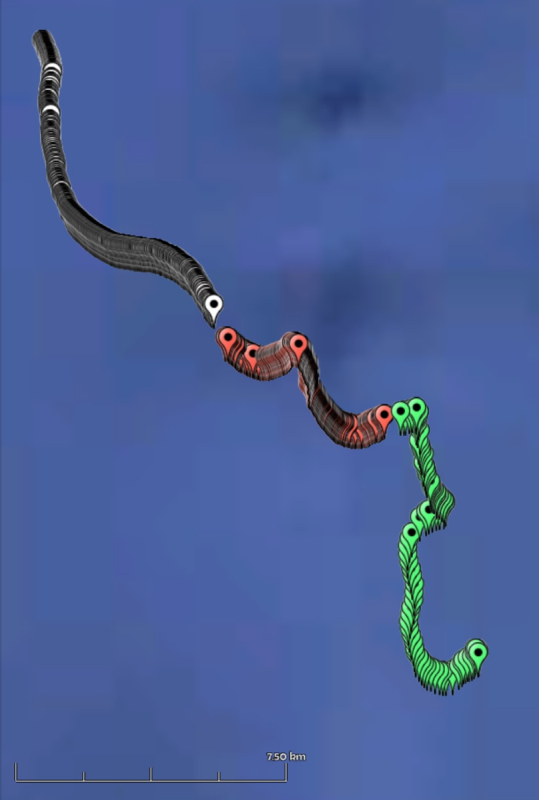
23 November: empty ocean?
Thanks to the high primary productivity in the waters we sail through, there is a lot of activity by fishing boats. In addition, there is a lot of ship traffic of container vessels. Therefore, we are always happy to find back the string of orange buoys that keep the drifting traps afloat. With the present sea state we can spot them easily from afar; can you see them in this picture?
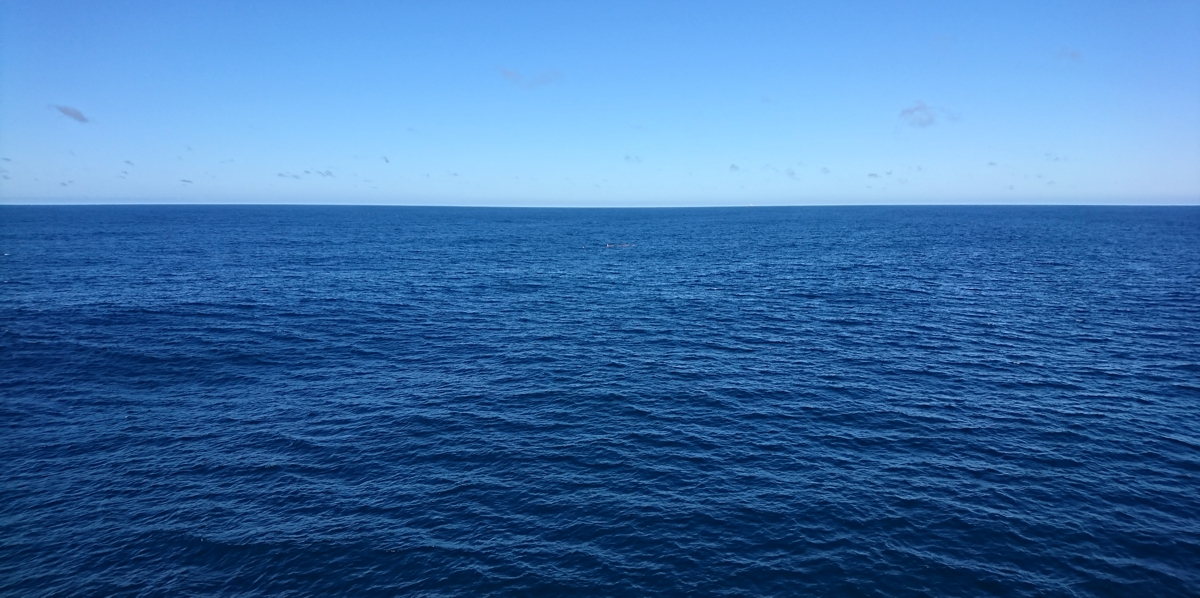
22 November: dust ahoy!
Nowadays computer models are so advanced that they can predict the occurrence of aerosols, in this part of the world that is predominantly desert dust. This forecast –downloaded from the Windy.com website—was made on Thursday 22 November 2018 and shows the predicted situation at the start of Sunday 25 November 2018. The picture not only nicely shows large amounts of dust suspended in the atmosphere, but also where this material is going; the little white arrows indicate prevailing winds. The ship’s position is indicated with the yellow arrow and we expect to collect some Mauritanian dust. Over the continent the largest dust source on earth is also clearly indicated: the Bodélé Depression in Chad. Finally, the zone where the northeast and southeast Trades meet, a.k.a. the Intertropical Convergence Zone (ITCZ), can also clearly be distinguished because dust tends to concentrate along this boundary between the northern- and southern- hemisphere wind systems and travel westwards across the equatorial Atlantic Ocean.
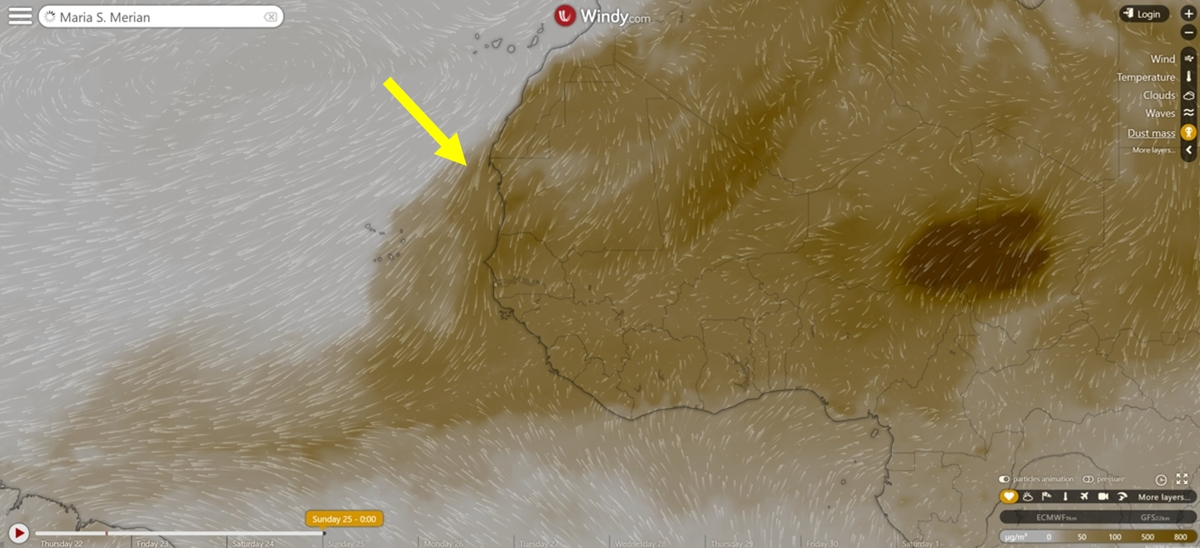
21 November: drifting traps
Another way to study what material is settling from the sea surface to the sea floor is by using so-called “drifting traps”. These traps consist of four Perspex tubes that are open at the top and through a small weight at the bottom and a gimbal construction they remain upright. Here you see an example of one of the three gimbals with four tubes that bosun “Plinki” is lowering into the water. We have three such sets that we typically suspend at 100m, 200m and 400m below the sea surface.
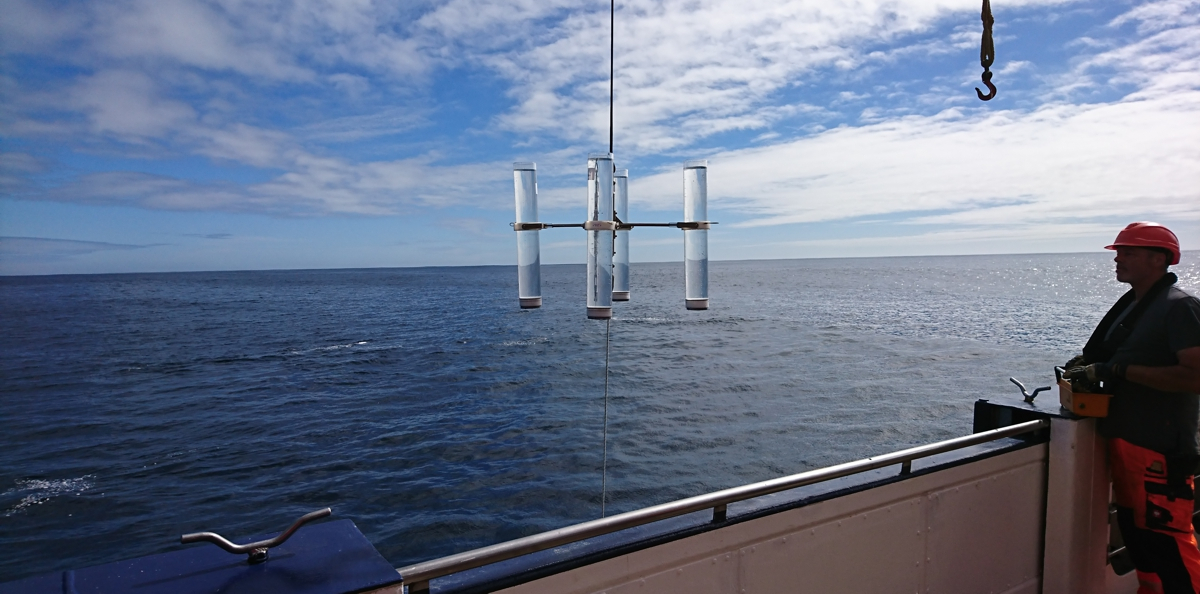
We are sailing through an area that profits from cold and nutrient-rich water that is upwelling to the surface, causing high primary productivity. After the traps have been drifting free for 24 hours, they contain quite some material, amongst other the green fluffy stuff that you see in the photo below.
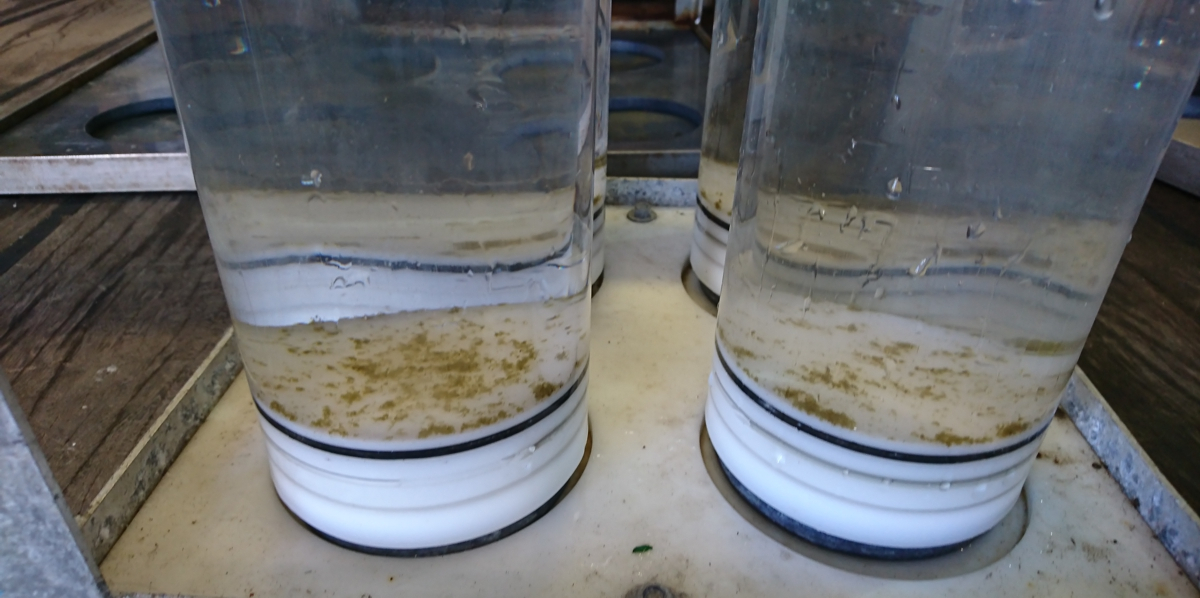
20 November: quiet sunrise
As you can see, the sea is amazingly calm due to generally calm conditions at sunrise. The wind (which gets triggered by the temperature difference between land and ocean) usually gains strength throughout the day but at the moment the sea surface is hardly stirred at all. We do notice the effects of a huge low-pressure cell that caused havoc on Tenerife a few days ago; the energy that was released more than 1000km away is still noticeable as a 6m high swell. The skies are almost disappointingly bright, at least in terms of the presence of Saharan dust….
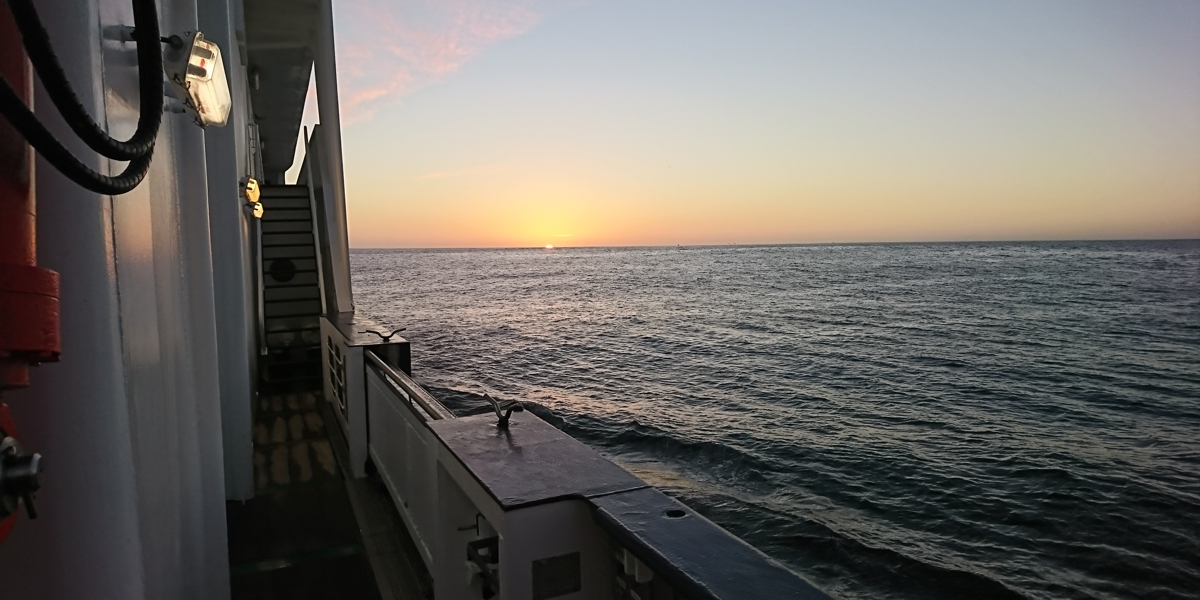
20 November: tour d'engine room
Research Vessel Maria S. Merian [named after the famous entomologist Maria Sibylla Merian (1647-1717)] is a fairly new and very modern ship. 1st engineer David proudly provides a tour through the engine rooms and tells us all about the special propulsion system –allowing very precise navigation— the “blue angel” predicate –no waste whatsoever goes into the ocean—and a score of other tricks and novelties that make the ship a very pleasant sailing laboratory.
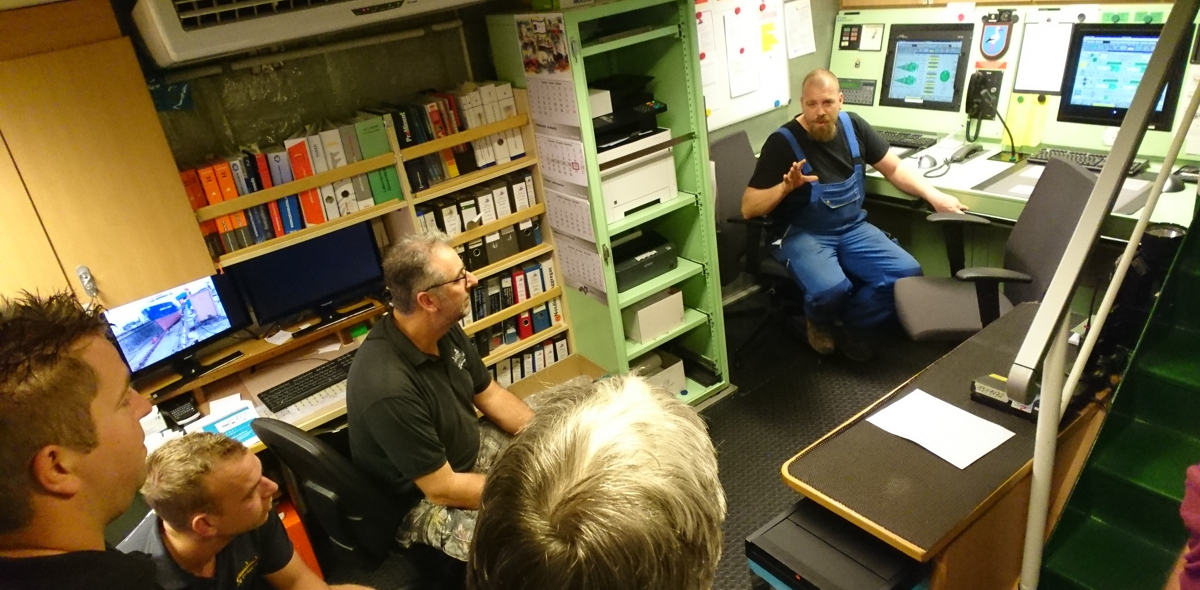
19 November: colourful mud
Despite all the fancy ways and techniques to study seafloor sediments, we always rely on the good-old Munsell colour system, originally designed to classify soils and widely accepted to also classify marine sediments since the early 20th century. Here you see Jane (Univ. Westminster, UK) and Gerard (MARUM) try to settle on the colour of the sediments in one of the multicore tubes. The lower the amount of oxygen in the sediments, the greener their colour is. Saharan dust causes colours of orange hues….
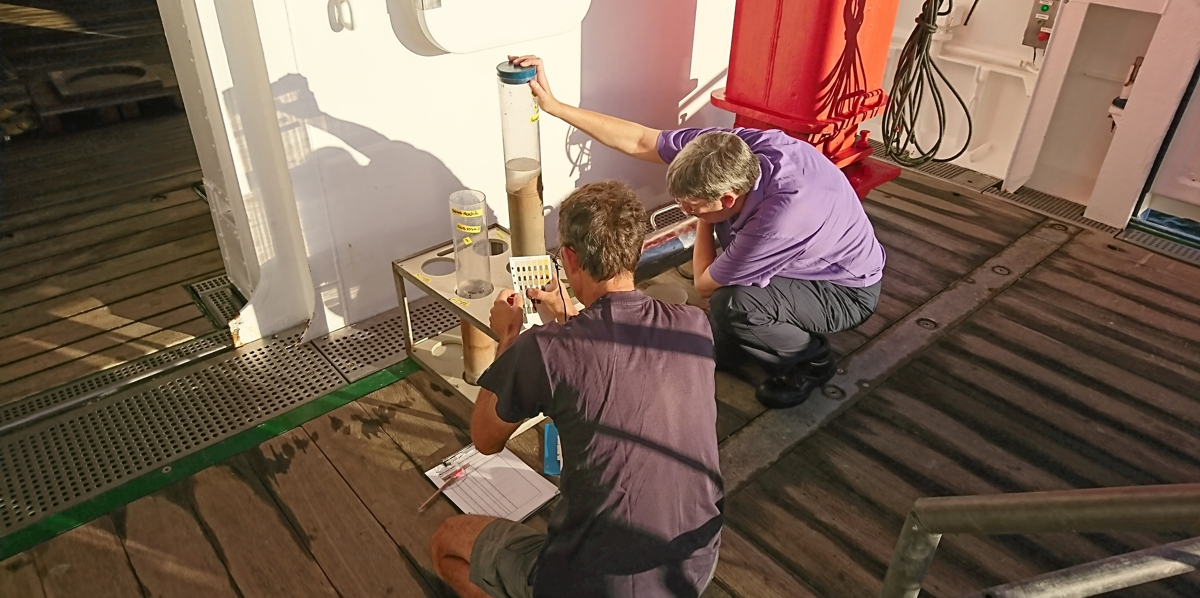
18 November: sampling seafloor sediments
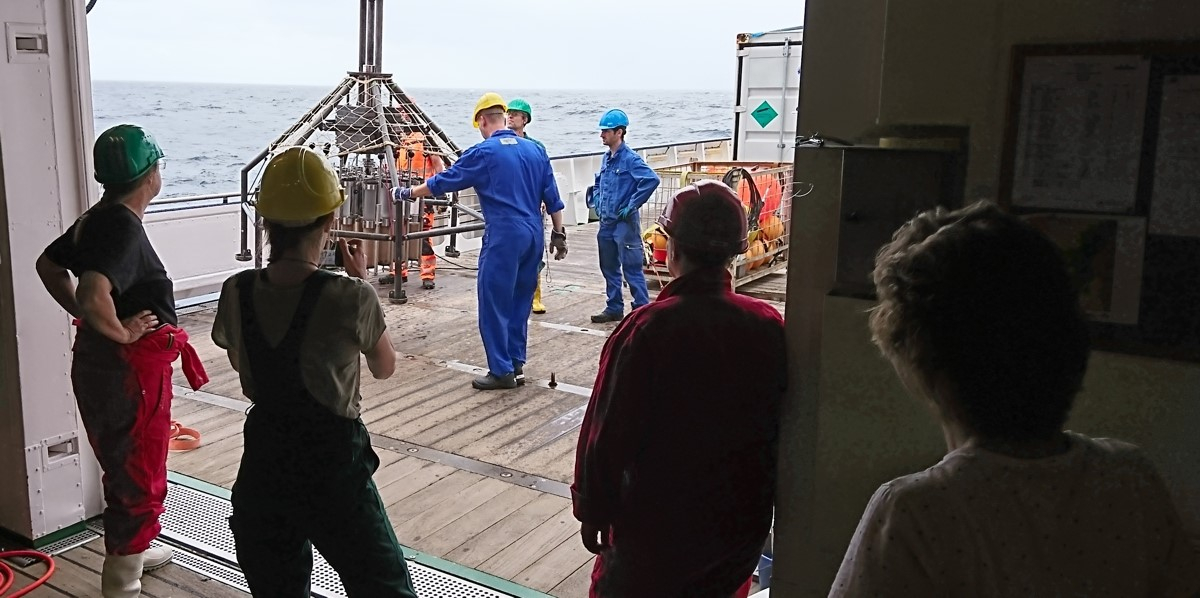
Next to atmospheric dust collection, there are many other ways of sampling going on during this expedition. One of them is the sampling of sediments from the bottom of the ocean, more than 4km below the ship. Here you how a so—called multicore (muc) is being recovered after she had been lowered to the seafloor and stabbed twelve perspex tubes into the sediments. Scientists from many different disciplines like geology, paleontology, paleoceanography and microbiology are standing around to share the material and to prepare it for the specific studies that they plan to do both here on the ship as well as at home in the lab.
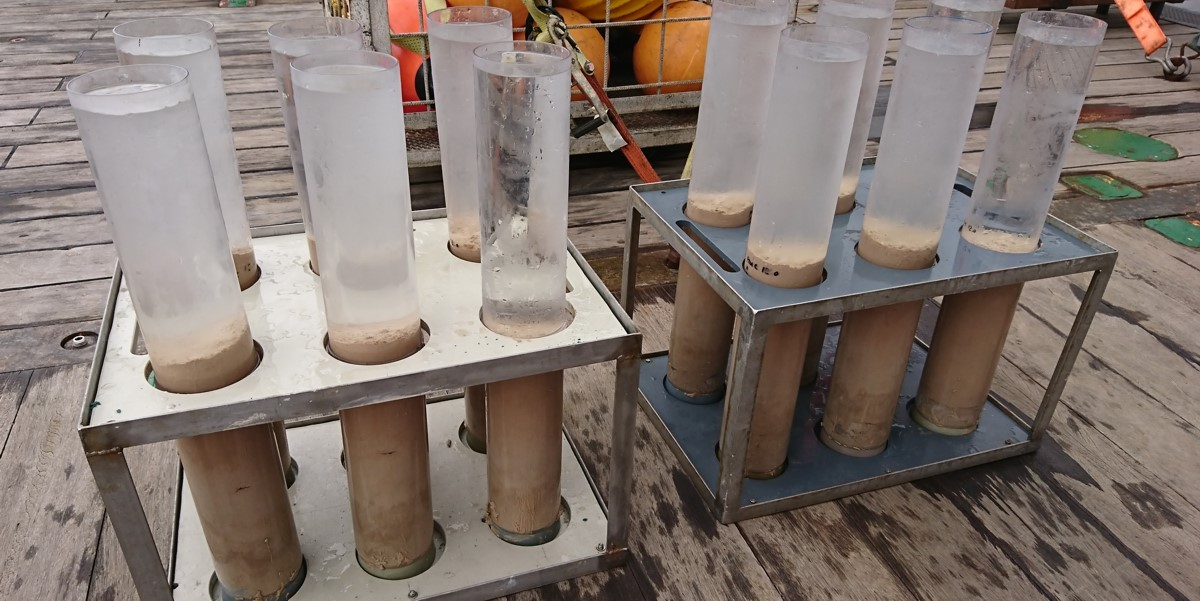
16 November: in for another year
Here you see buoy Carmen happily floating in the eastern equatorial North Atlantic again! She has been sending us twice daily updates already and will soon start collecting dust from the atmosphere until we pick her up once more early 2020. Happy sampling!
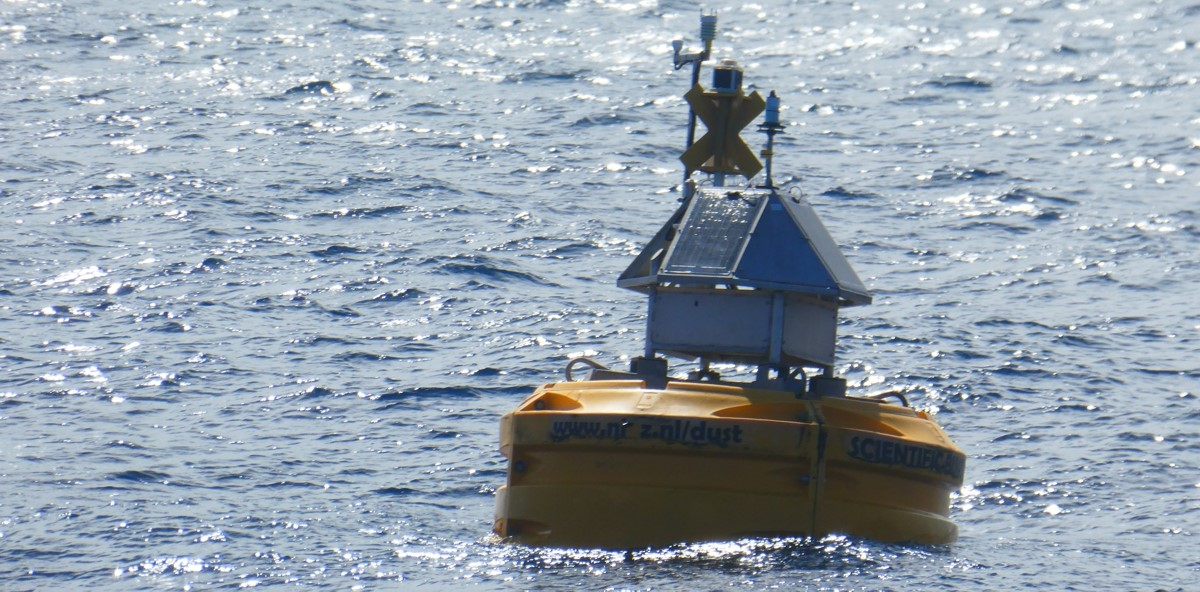
16 November: final last check...
Now that the dummy buoy has been deployed successfully, the last step of the procedure is to replace the dummy with the real buoy. Here you see NIOZ technicians Barry Boersen and Jan Dirk de Visser checking the connections between chain and buoy. The mooring needs to withstand rough conditions and constantly moving seas. Next to being the dustiest part of the Atlantic Ocean, it is also one of the windiest places due to the northeast Trades that practically always blow (and sometimes carry dust).
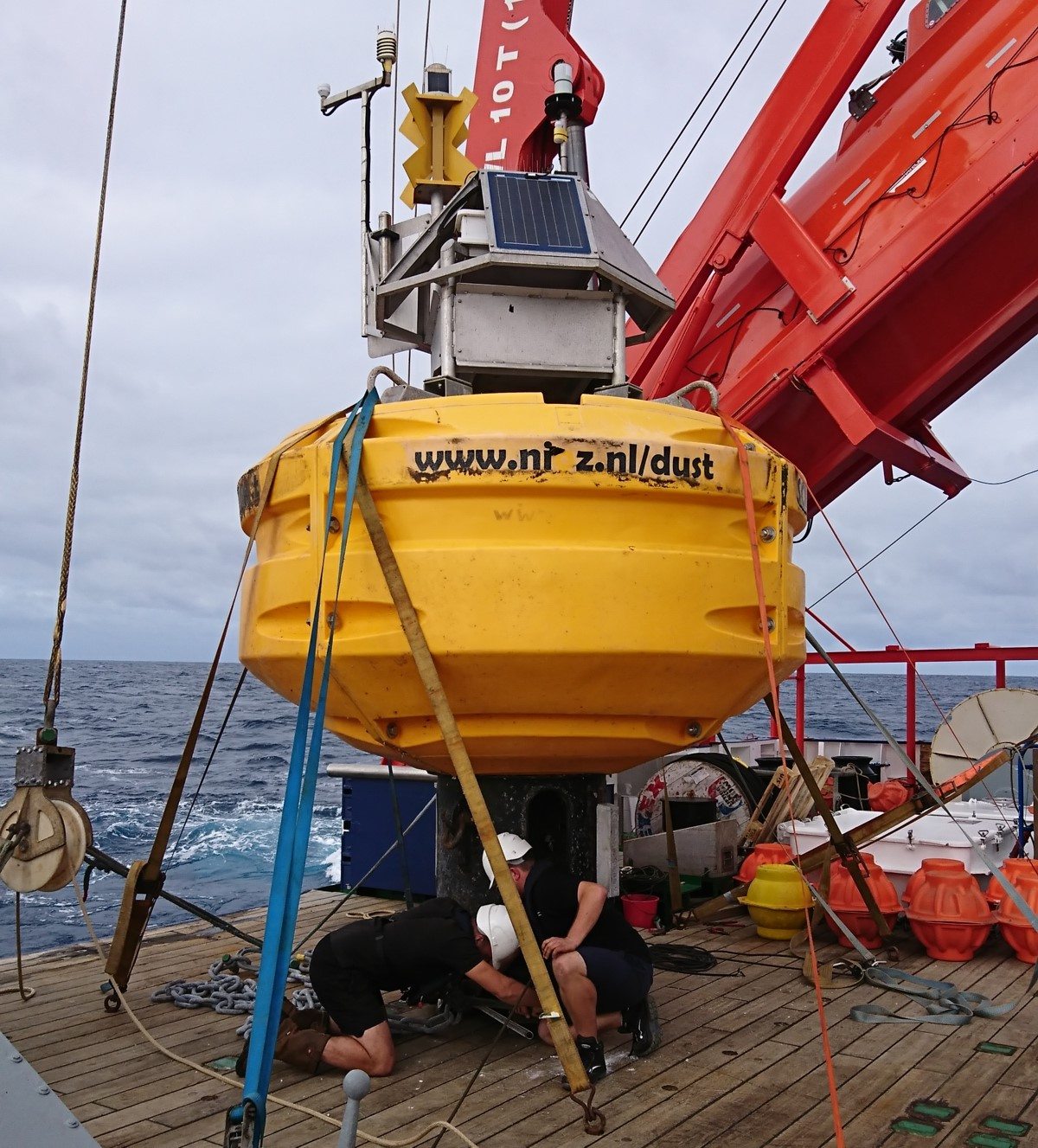
16 November: check, check, double-check
Before deploying the anchor and the two releasers that hold the mooring, they are getting one final check by NIOZ technician Bob Koster. Each releaser has its own pre-programmed activation codes, which we obviously need to know well. The next cruise is scheduled for early 2020 and then we want to be able to communicate with the releasers and –through an acoustic signal that we send from the ship down to the bottom of the ocean at 4200m— give them the order to let go of the anchor so that the whole mooring can be lifted to the ship at the ocean’s surface.
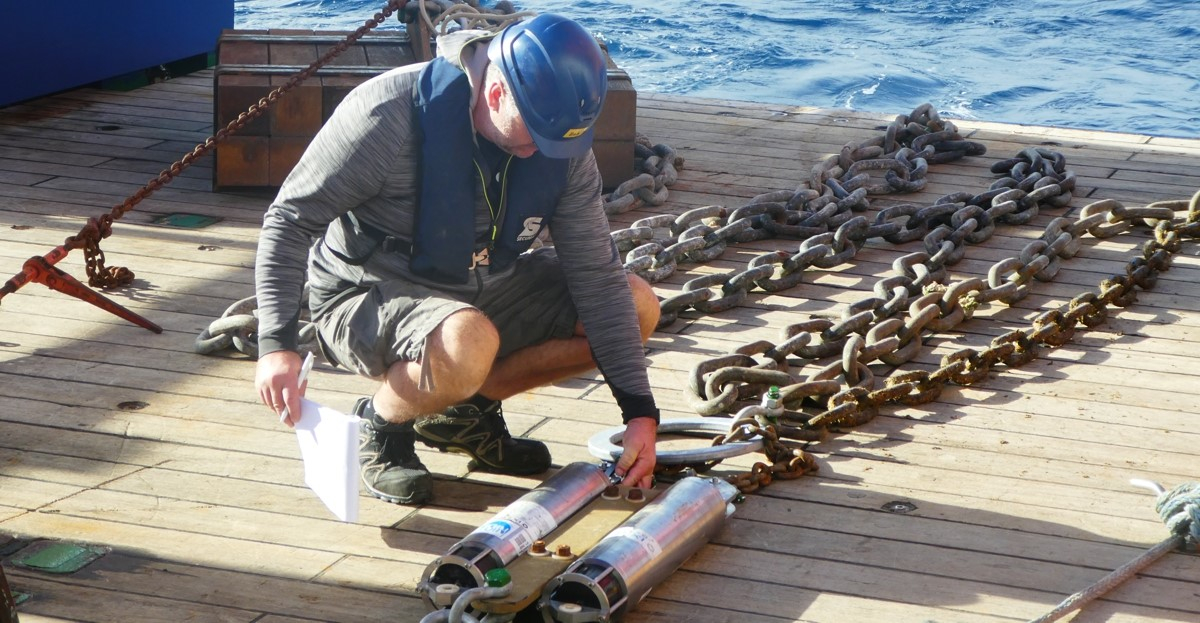
16 November: re-deploying buoy Carmen
In the early morning we start the deployment of buoy Carmen, starting “from the top”: the buoy first, then 4km cable and the anchor last. Instead of the real buoy we deploy a dummy because the weight and speed of the anchor sinking to the bottom might drag the top-buoy under shortly, which we don’t want to happen to the buoy that is full of electronics! The “smartie” that you see on this picture and that we use as a dummy has a buoyancy of about 500kg, which will pop up at the surface once the anchor has landed on the sea floor. We start early, so that the parts of the procedure during which we need to see the dummy pop up is during bright daylight.
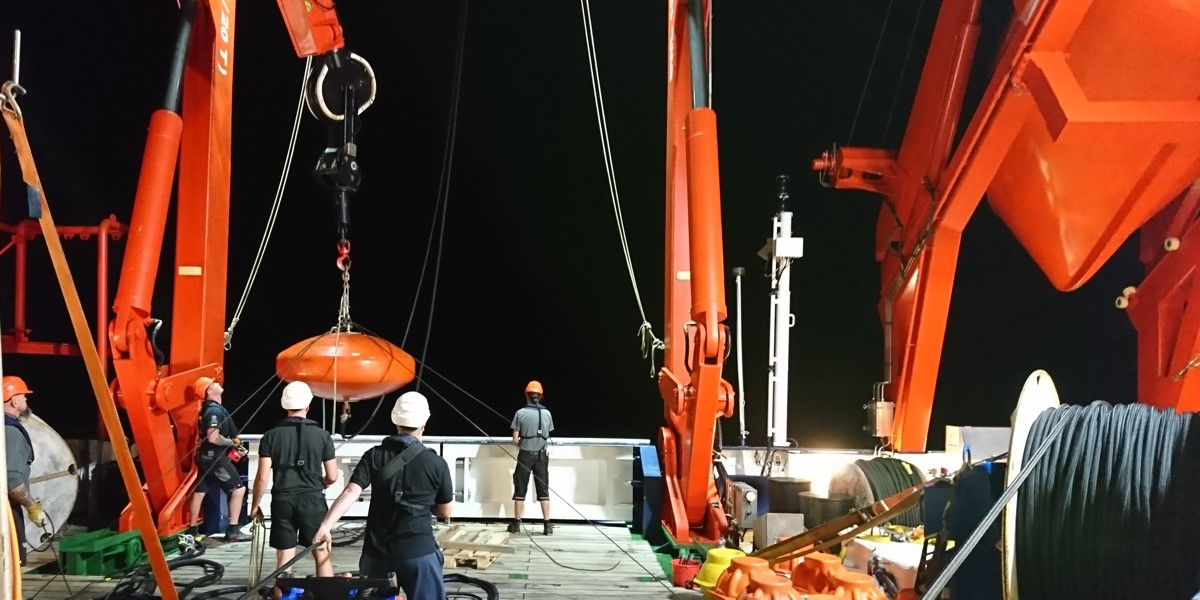
16 November
Being in the ocean for longer time causes not only growth of all kinds of biology, there is some chemistry involved as well: thanks to the salts that are dissolved in it, sea water is pretty corrosive to metals! Here you see a fresh aluminium-anode that has been attached to the buoy and the remainder of such a “sacrifice-metal” bar after it has been in the water for two years. By fixing such an Al-anode to the stainless-steal housing of the buoy, we make sure that the steel stays intact and strong.
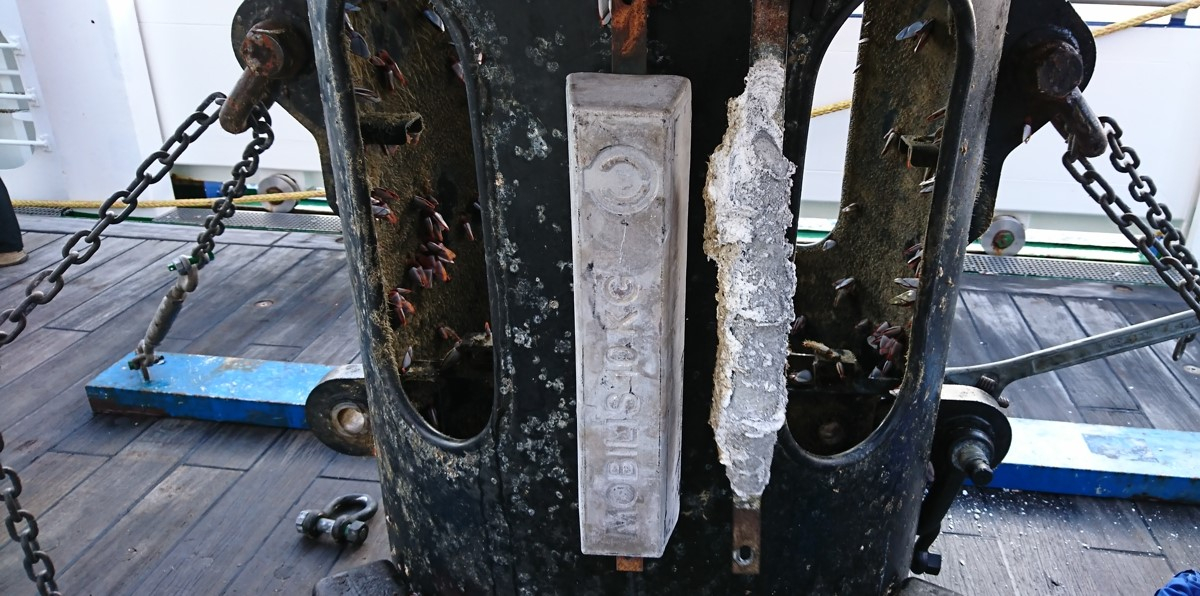
15 November
Here you see NIOZ technician Bob Koster servicing various parts of the aerosol tower that is be place on buoy Carmen. All moving parts are checked and various pieces of equipment get new batteries, a software update or a new set of instructions for the next year. After the tower has been prepared and programmed for another year, it will be place on top of the buoy that is standing on next.
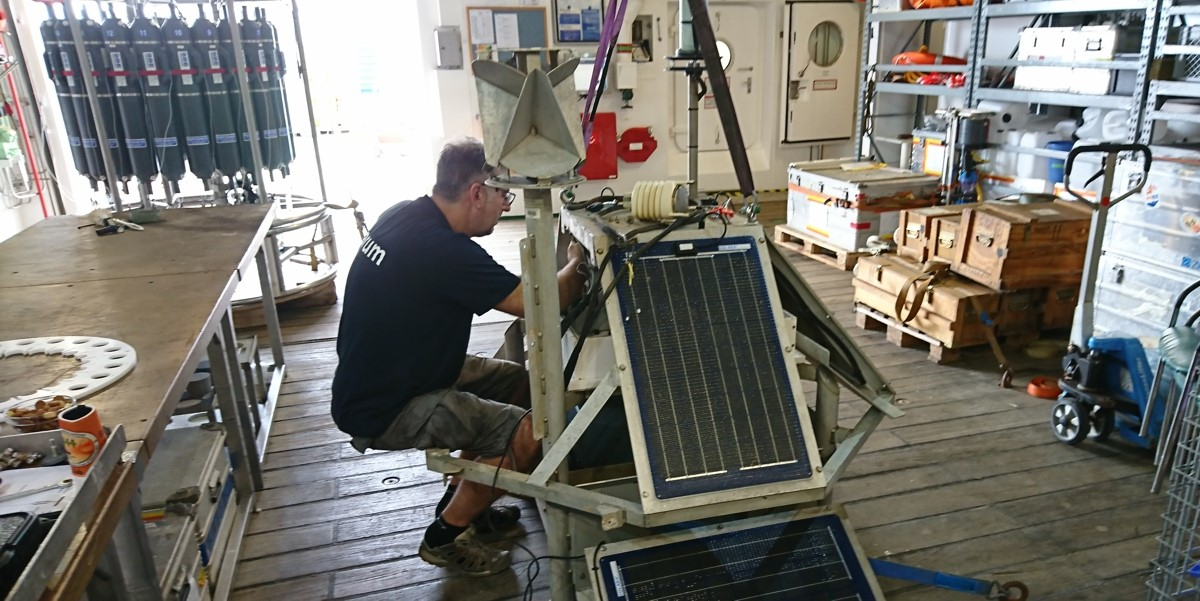
15 November
After having “harvested” the full dust filters of buoy Carmen, it is now time to prepare her for another year of sampling. Here you get a glimpse into the box that contains the carrousel with 24 filters. Filter nr 12 is yet to be loaded. You can also see the spring that is used to provide the required pressure with which the filter cups are pressed into the chimney so as to prevent leakage of “false air”.
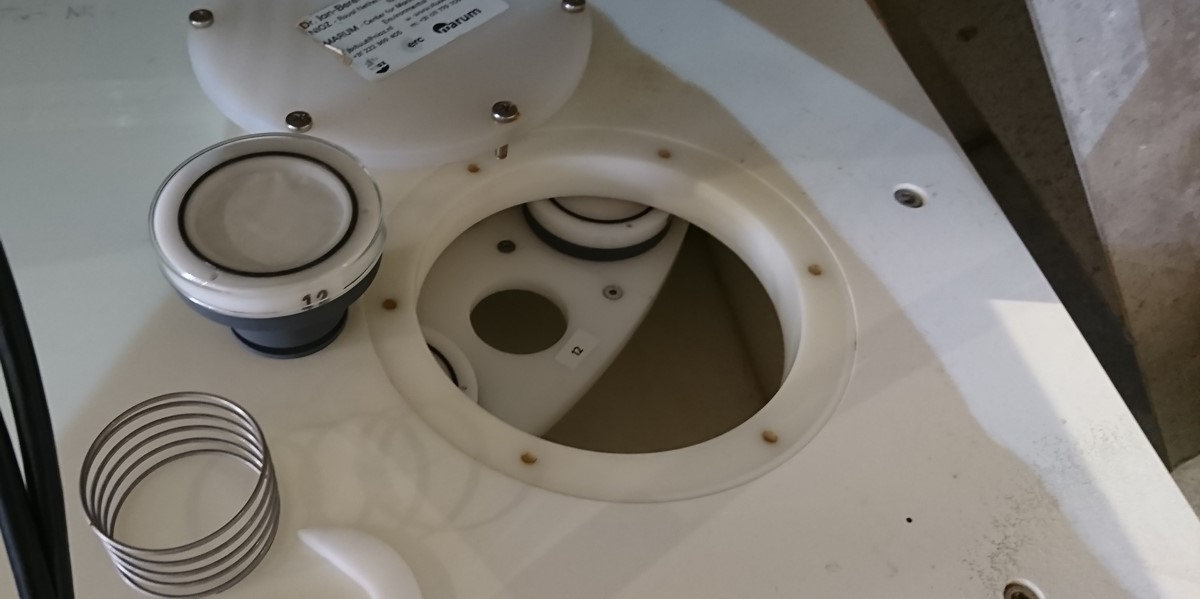
15 November
Next to the MWAC sampler, the dust-collecting buoys are equipped with fancy dust collectors in which air is pumped through filters. Here you see an example of such a filter after it has sampled the atmosphere for 22 consecutive days. You can clearly see the orange colouration of the filter, which is entirely caused by Saharan dust. We will study the composition (particle size, chemistry, mineralogy) of this dust when we’re back at NIOZ, and hope to draw conclusions about the potential of this dust as an ocean fertiliser.
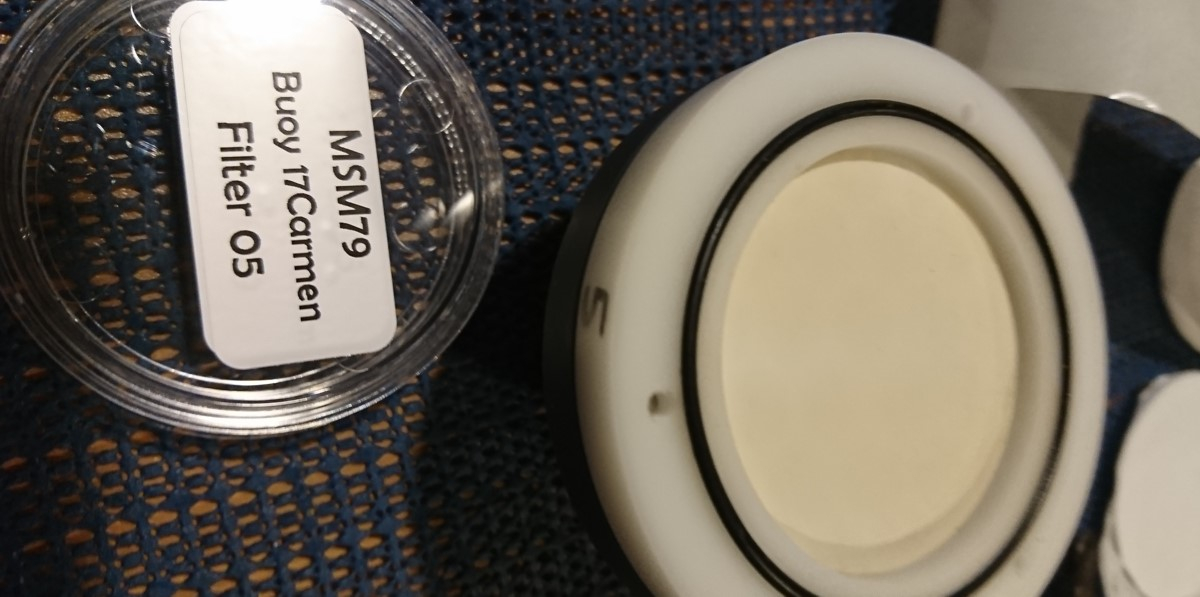
15 November
The dust-collecting buoys were constructed at NIOZ, in close collaboration with MARUM and consiste of sophisticated instruments. The simplest of them all is this so-called MWAC sampler (MWAC is the abbreviation of Modified Wilson And Cooke, a much-used passive dust sampler) which allows air to pass through and deposit its sediment load. In fact, the material from this very simple dust collector has already resulted in a Science-Advances paper! (the paper is in press right now, keep an eye out on this website for the actual paper that will be published soon!).
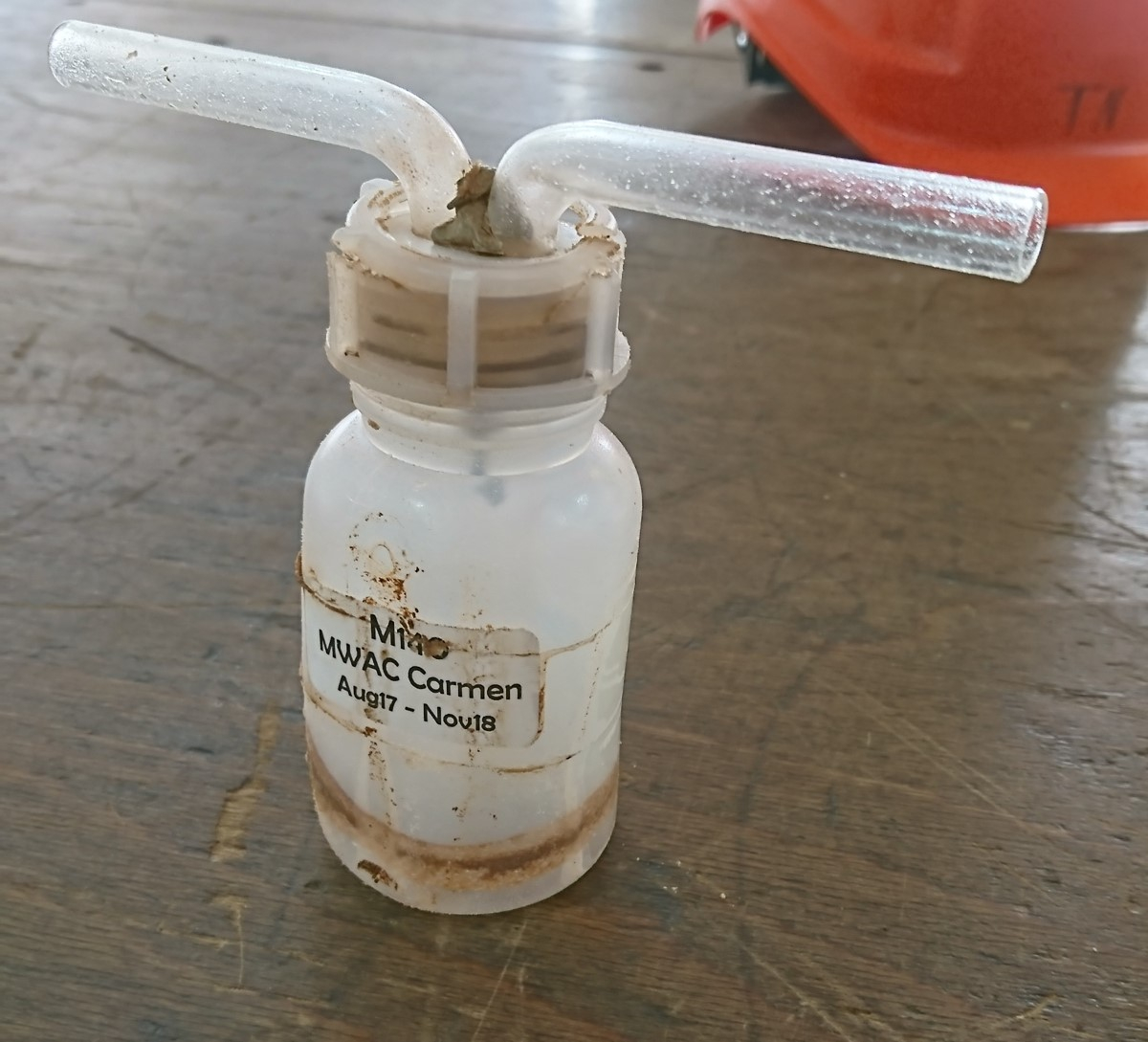
14 November: buoy Carmen with beard
Having swum in the nutrient-rich waters offshore Mauritania has caused buoy Carmen to be completely overgrown with gooseneck barnacles. Although these barnacles are considered a delicacy in southwestern Europe, we are not really tempted to try and eat them.
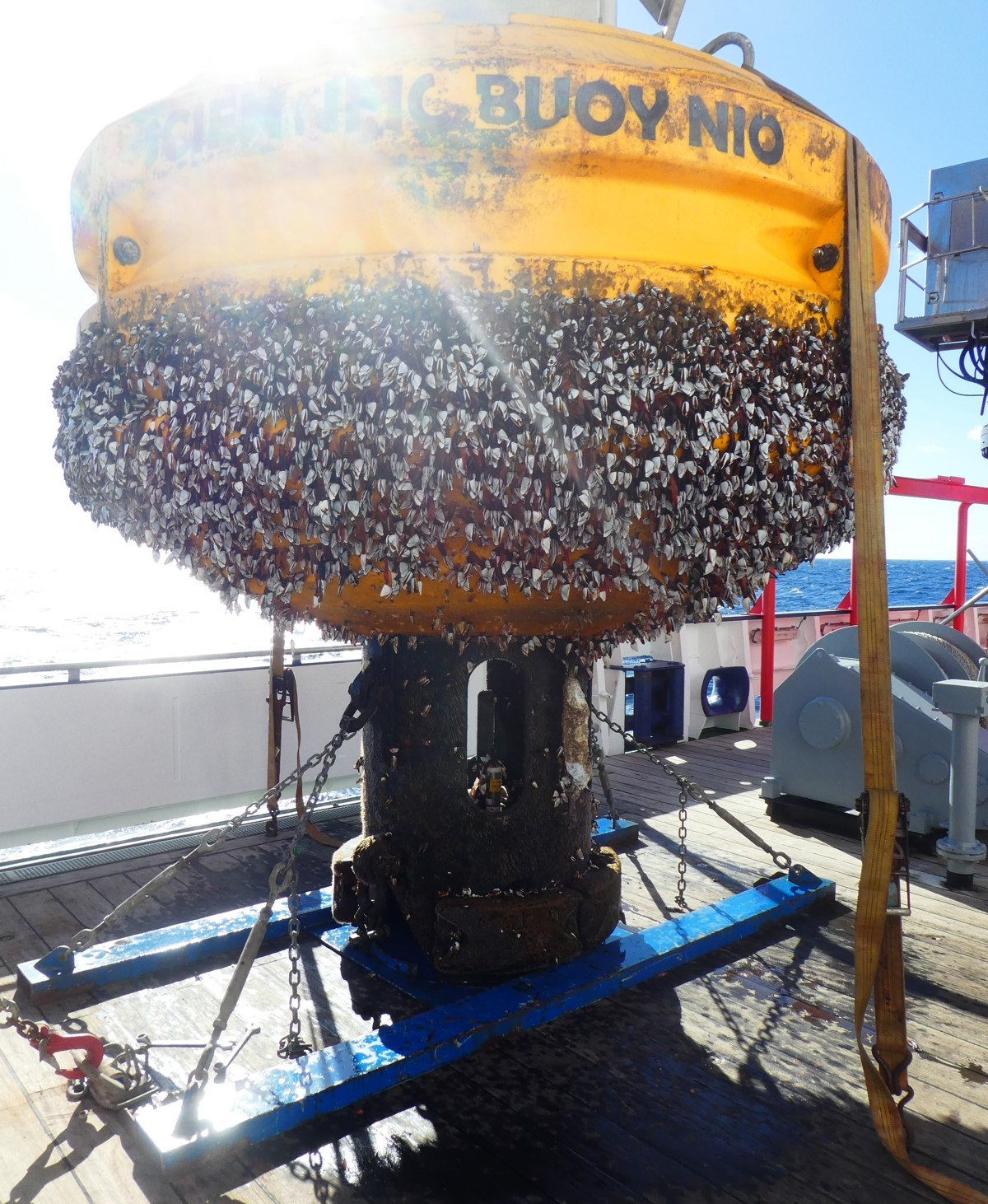
13 November: good catch!
We caught a buoy! Although one could not tell from this picture, the sea is pretty stirred-up so that we needed to pick up the buoy from the aft of the ship. Thanks to the facts that the ship can be manoeuvred very precisely by master Ralf Schmidt and his team of officers on the bridge and that bosun “Plinki” and his crew on deck know exactly what they are doing, the buoy is collected safely and can now be hoisted on the deck of RV Maria S. Merian.
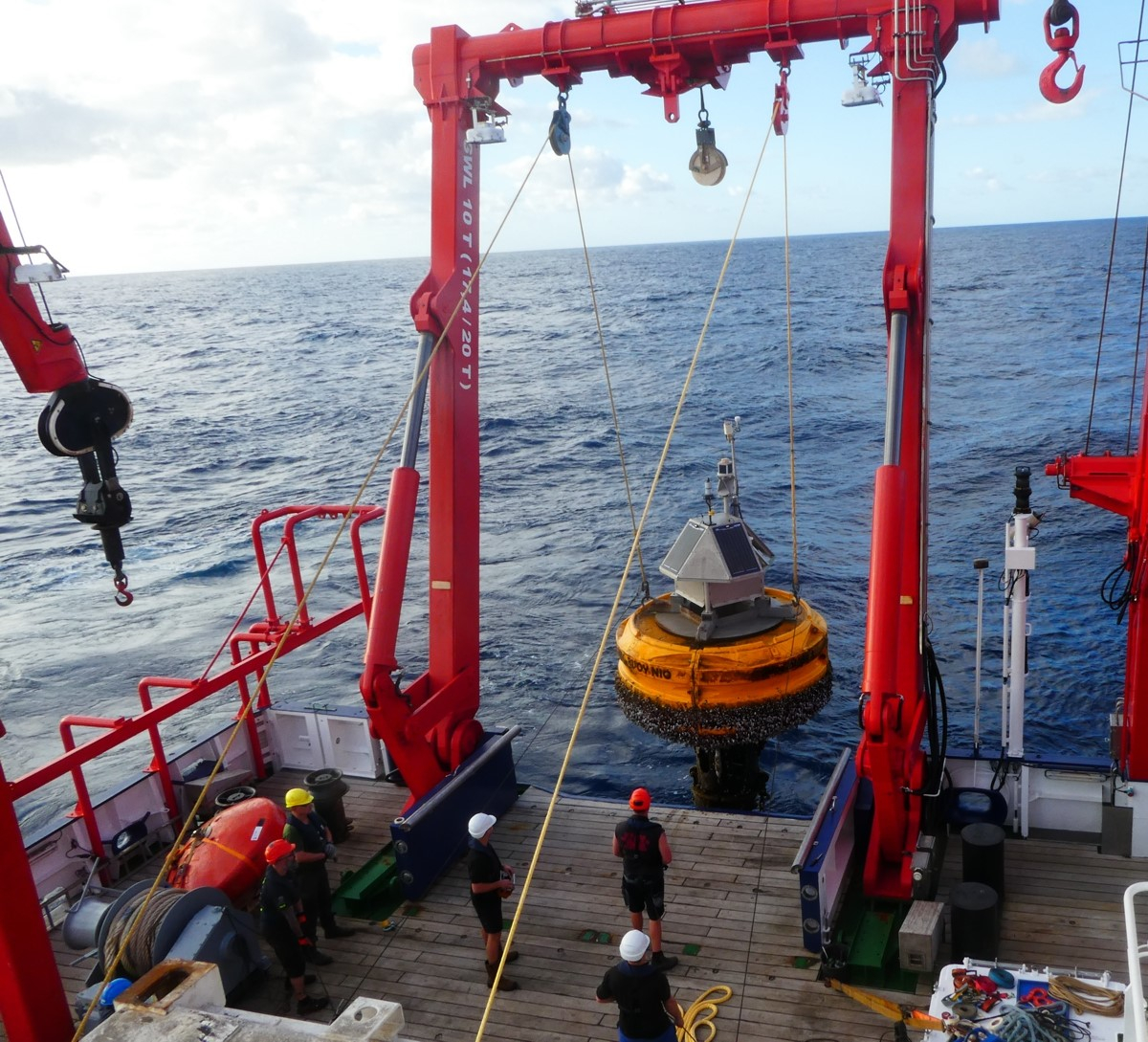
12 November 2018: Buoy Carmen
We are all pretty excited today as we will recover dust-collecting buoy Carmen. She was deployed during cruise M140 in August 2017 and so has been on her own for more than a year. Every day she’s been sending us eMails with status updates (position, meteo conditions, battery status, amount of sampled air, etc.) so we already know she performed really well. On the map with positions you can see that she has spent most of her time in the southwest part of her circle that the line allowed her to move in, thanks to the northeast Trades.
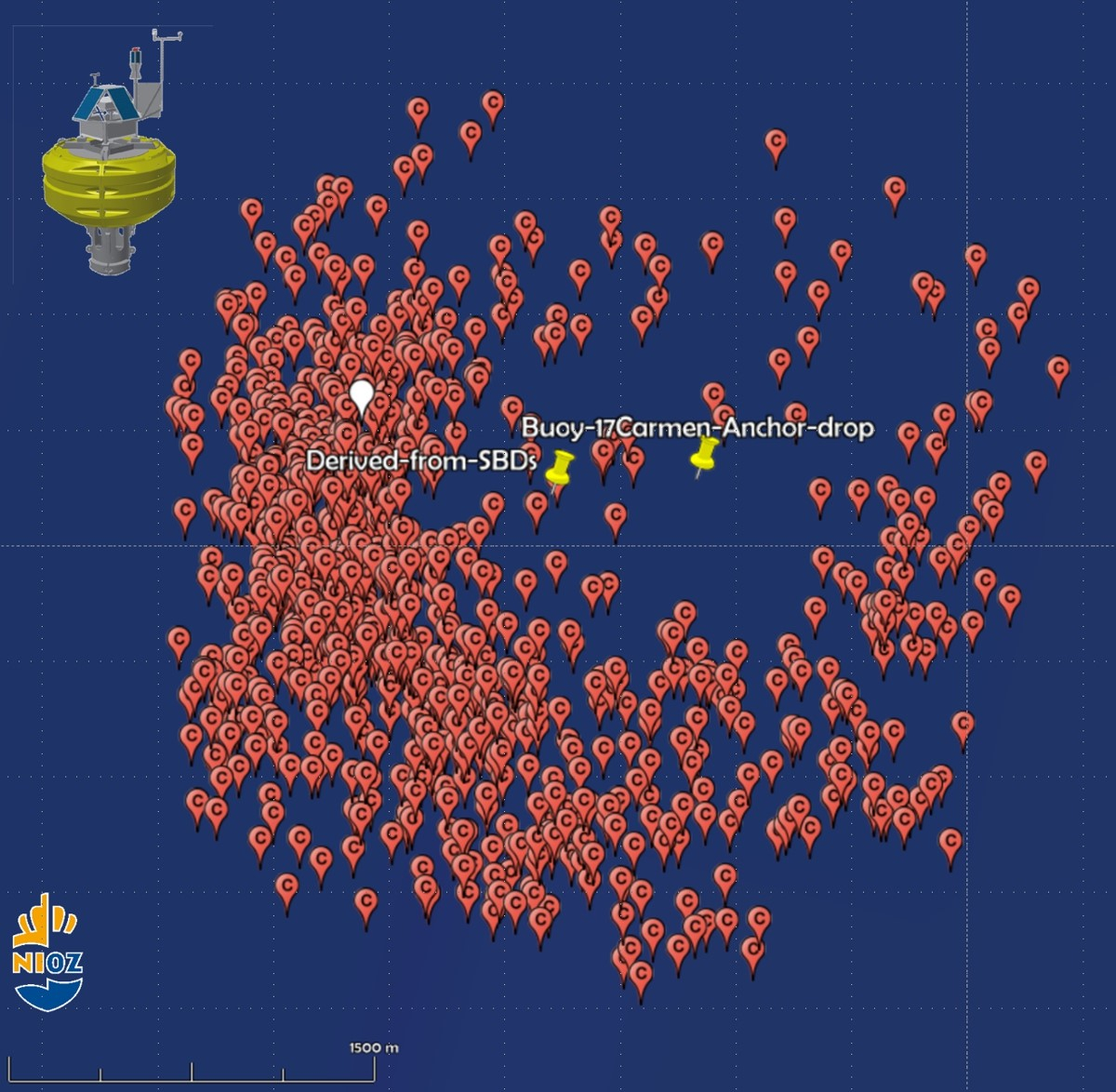
11 November 2018: sunrise
As the sun rises over the northwest African continent in the east, we know immediately if there is going to be dust around or not. Here you see how the atmosphere is hardly coloured orange at all so, unfortunately, no dust today.
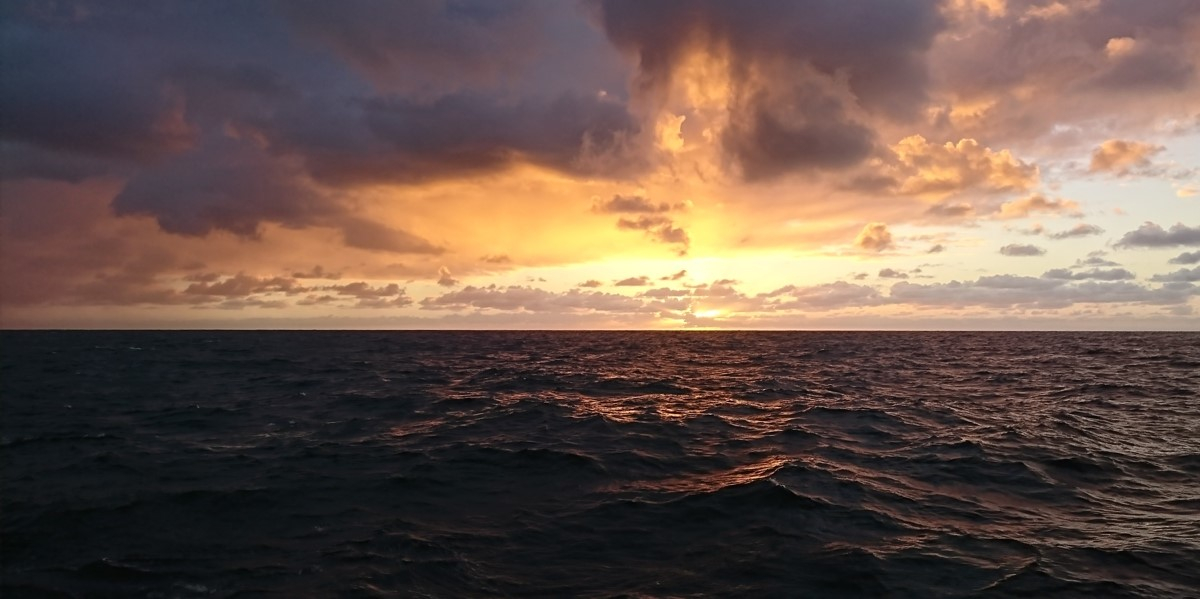
9 November 2018: adios Gran Canaria
We are leaving the harbour of Las Palmas de Gran Canaria and are on our way south towards the first station some 8 degrees latitude (about 900km) away. The weather forecast is pretty good and we will sail downwind and down the Canary Current, expecting an “easy ride”.
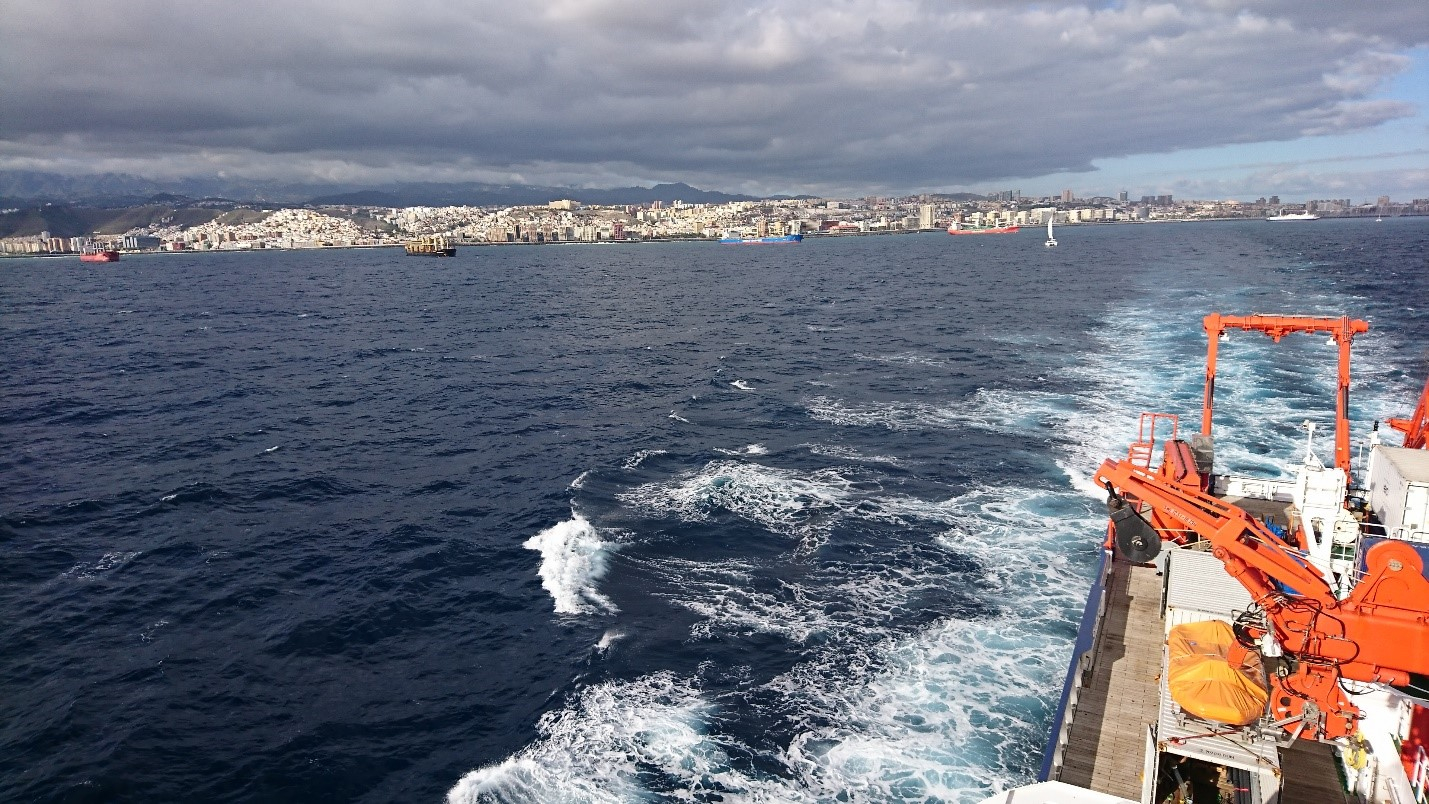
The pilot who helped us sail out of the harbour has been picked up and waves goodbye. We are on our own now and look forward to an exciting expedition!
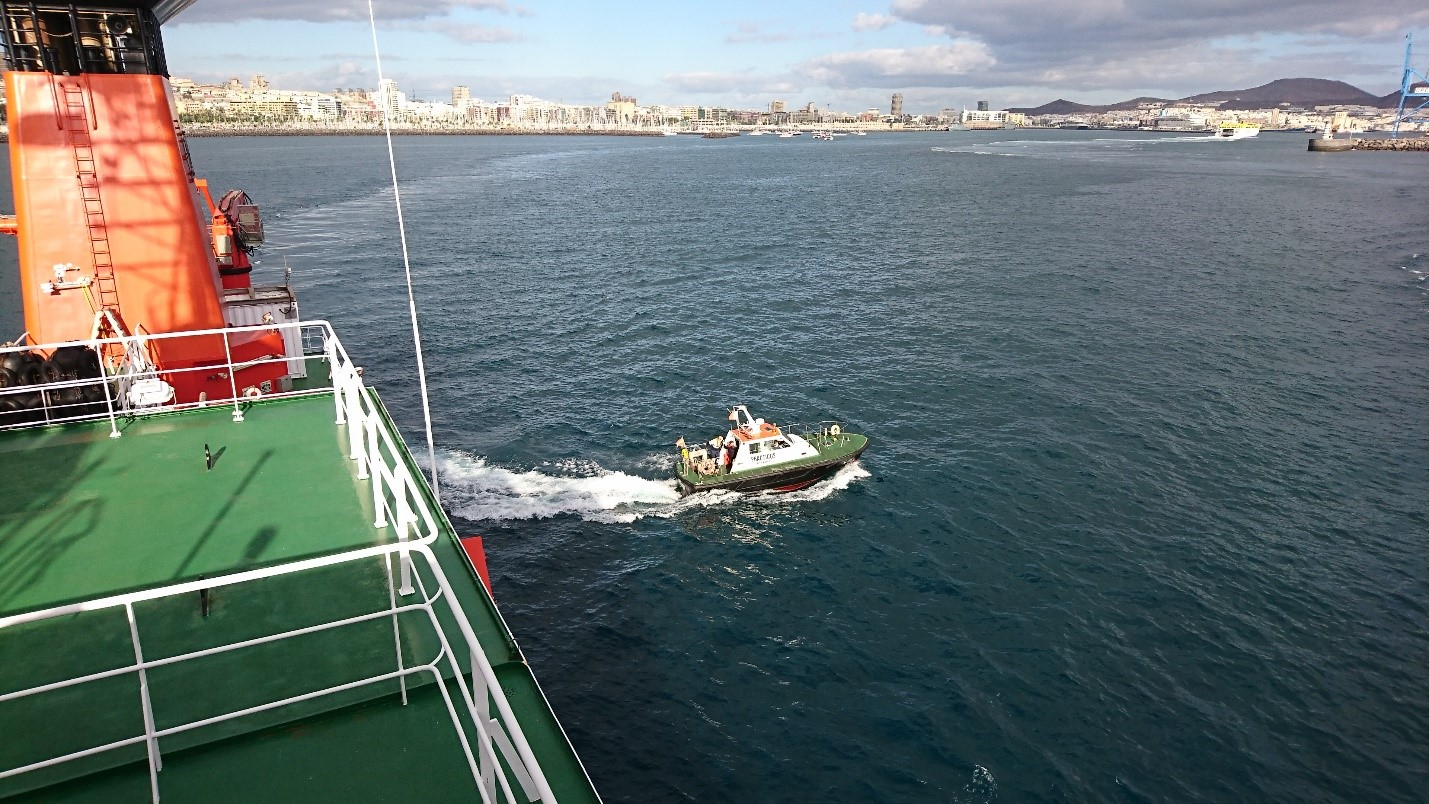
After yesterday’s instructions on how to prevent and overcome accidents and fires we are now getting acquainted with the abandon-ship procedures; we all gather at the must station with the appropriate clothes and gear and learn how to put on our life vest. We all feel very safe and taken care of!
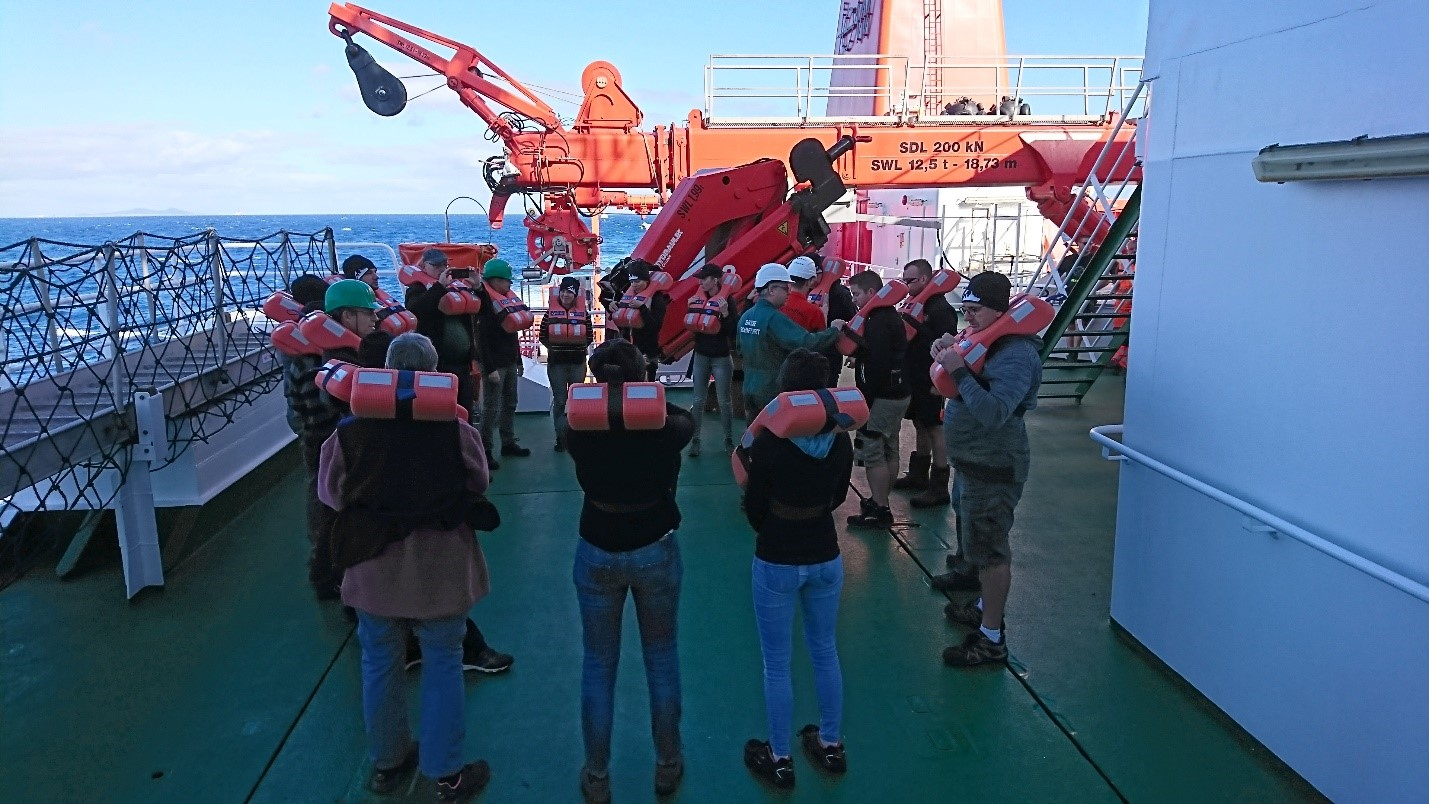
8 November 2018: final preparations before departure
While still in the harbour, we use the opportunity of the still lying very still to install our equipment and measuring instruments. Here you see how Bob installs the instruments we use to collect dust from the atmosphere. The bridge contains many instruments for atmospheric research and many people “at home” also benefit from our measurements. For example, the meteorological data that we acquire daily are stored in a meteo-databank and are used to make weather forecasts in many countries in northern Europe.
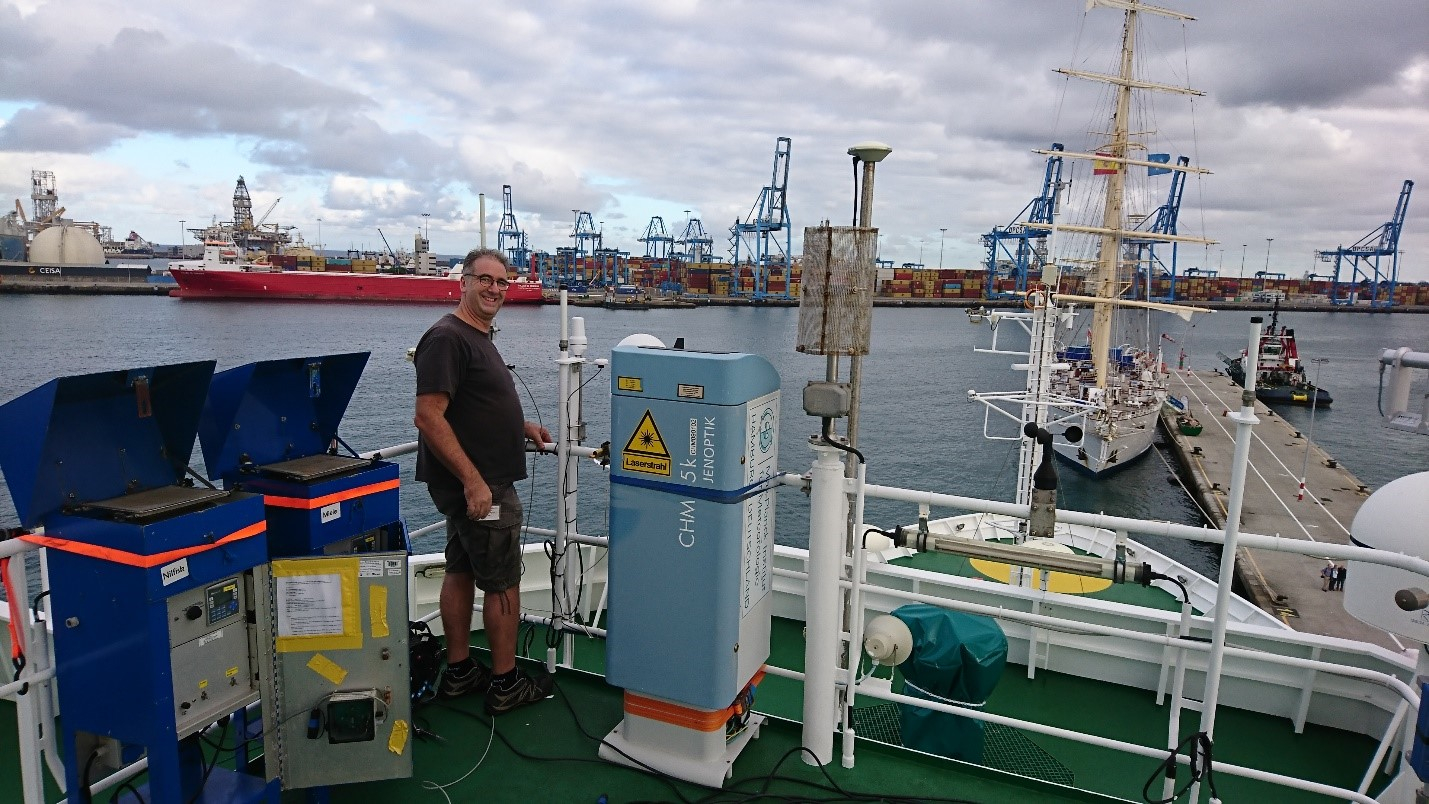
As part of the instructions of how to work safely on board the ship, we get detailed instructions on how to prevent, and - in the unlikely event of an incident - fight fires. Also, we are instructed in recognising the ship’s signals and in putting on our survival suit: one size fits most, but we hope to never have to depend on it!
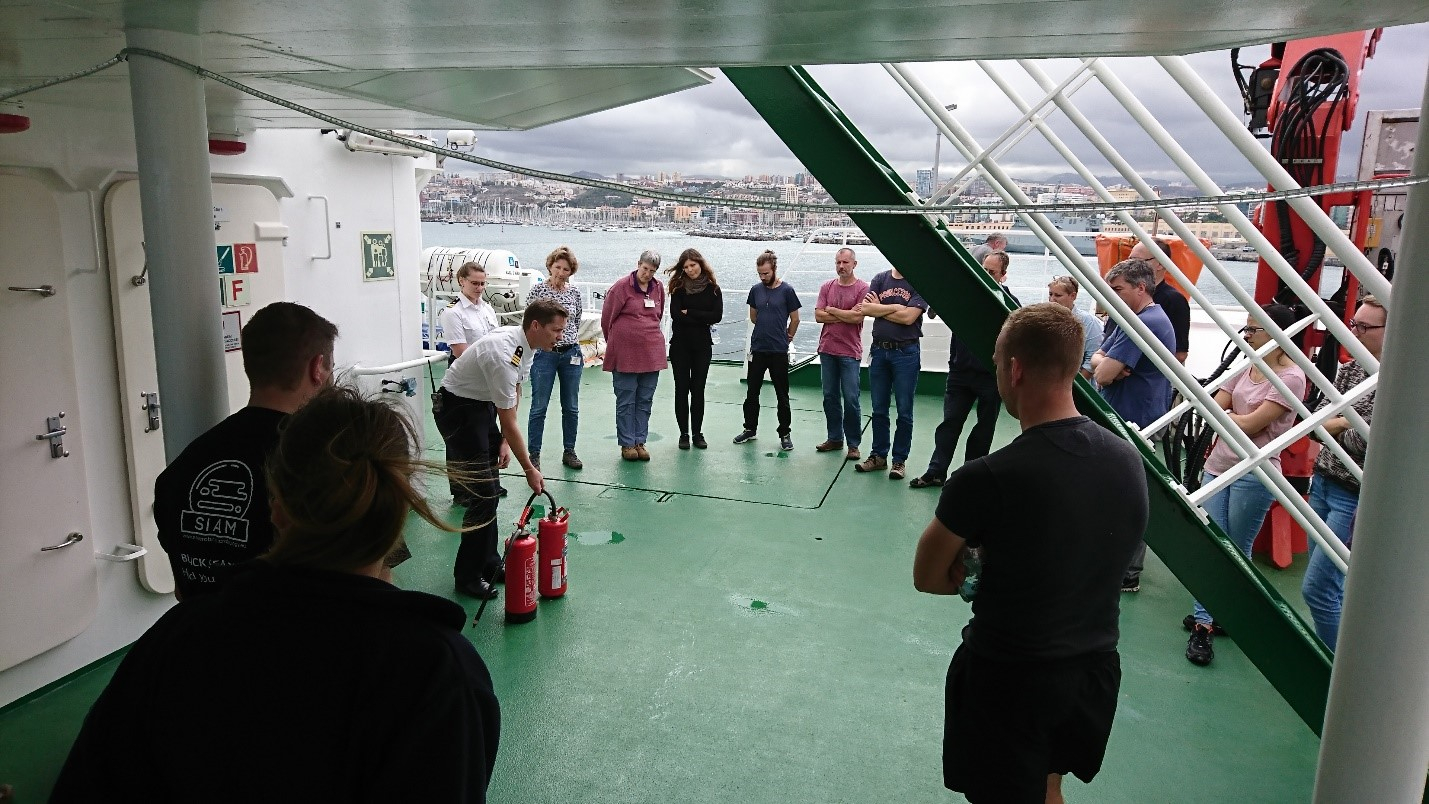
7 November 2018: Merian by night
RV Maria S. Merian in the harbour of Las Palmas de Gran Canaria, still tightly secured to the pier.
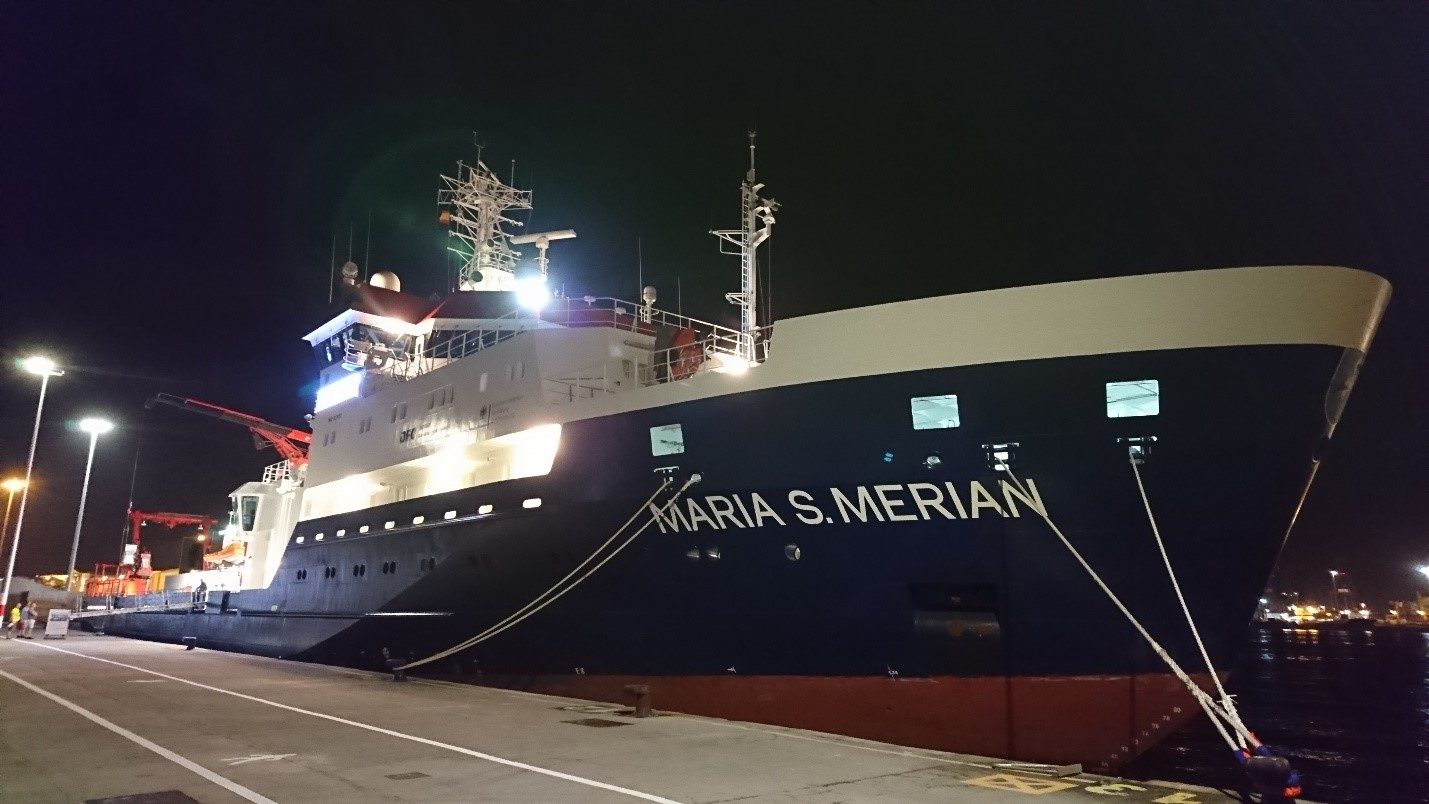
20 October 2018: no shops at sea
Well in advance of each expedition we need to think hard on what we'll need to do our work at sea in terms of tools and equipment, as there are no shops in the open ocean to buy things! Not only do we need new 3.5 Ton weights to keep the moorings in place but also e.g., laboratory gloves, batteries, empty vials etc. All these boxes filled with equipment and tools need to be brought to the ship in Edinburgh by the end of October, the stuff that we forgot to pack will have to be carried in our luggage when flying down to Gran Canaria....
